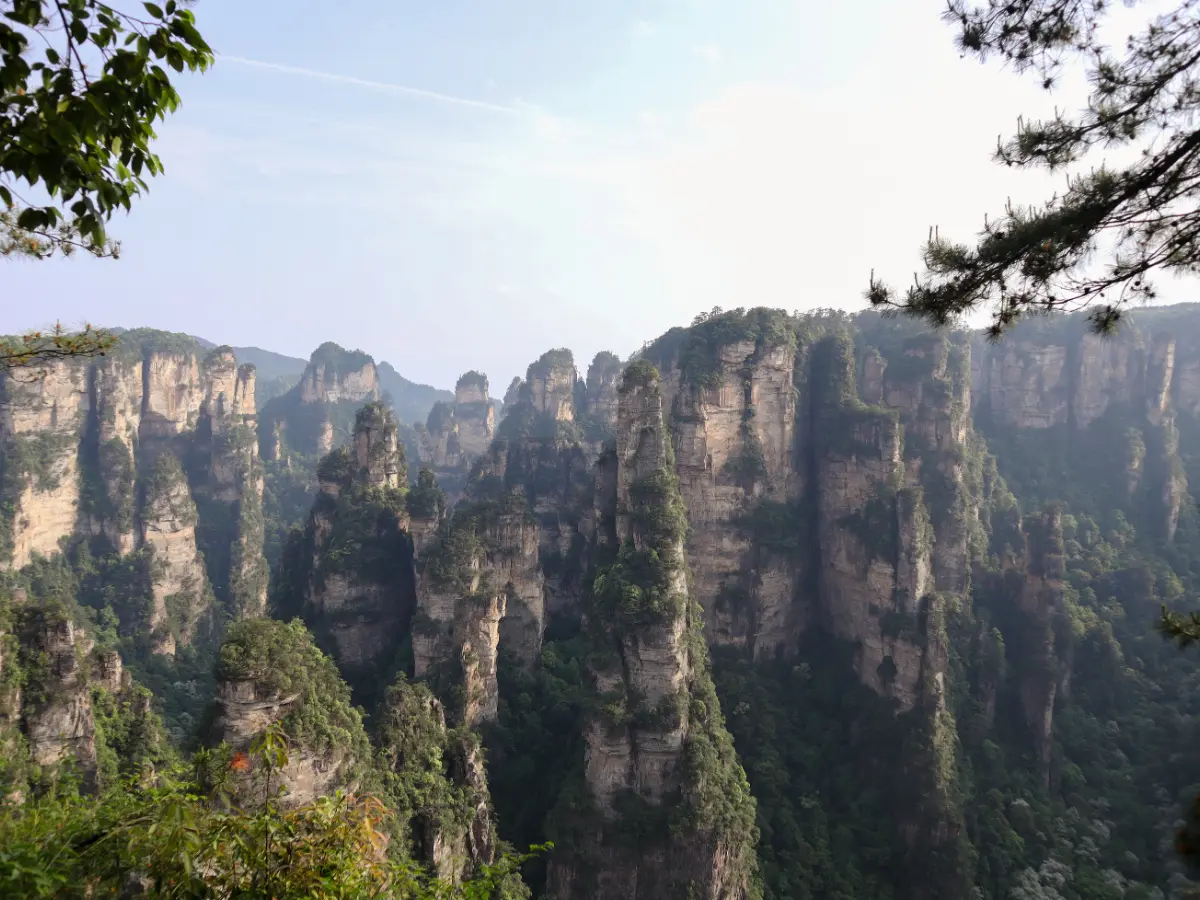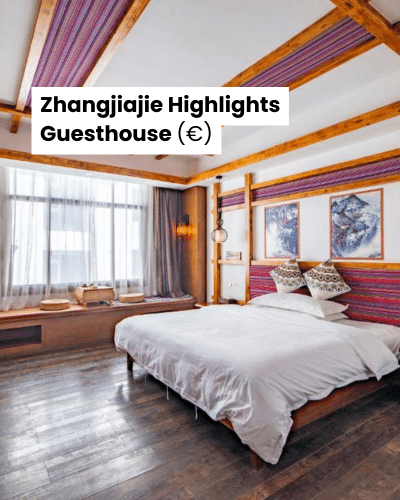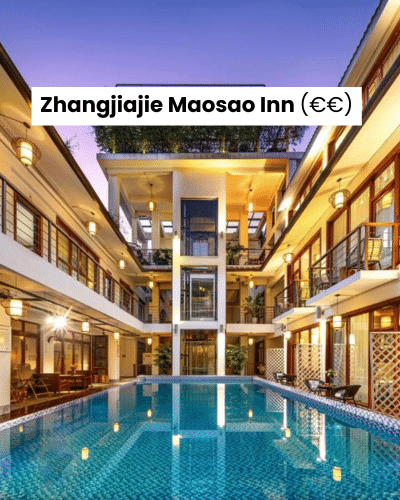Looking for the best Zhangjiajie itinerary to help you make the most of your time in the Avatar Mountains in China? You’re in the right place.
When I was planning my trip to China, Zhangjiajie kept popping up in images—but oddly, organizing a trip there seemed a nightmare. After going myself, I can confidently say: this place blew me away and it’s easier to visit than it seems.
It’s one of the most surreal landscapes I’ve ever seen. Think towering sandstone pillars, lush canyons, and misty peaks that inspired Avatar. No surprise it’s a UNESCO World Heritage Site.
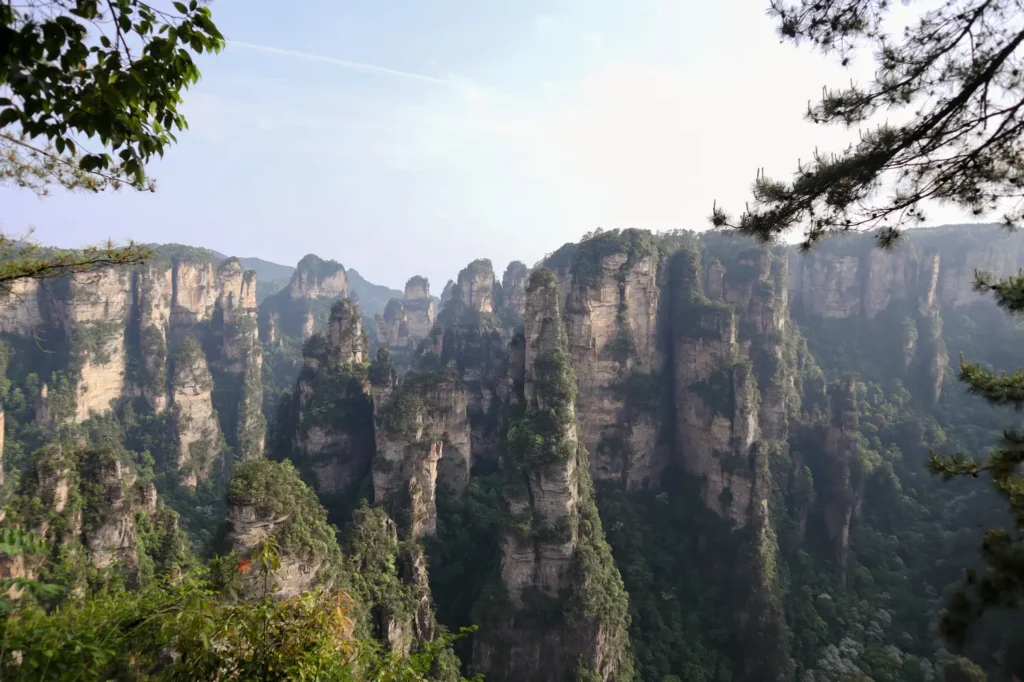
The park covers more than 260 square kilometers—so yes, it’s absolutely massive and planning your route in advance is key.
In this Zhangjiajie travel guide, I’ll walk you through the exact itinerary I followed to visit Zhangjiajie National Park in just 1.5 days—without feeling rushed. You’ll learn how to move efficiently around the park, what to prioritize, and how to avoid the confusing shuttle bus maze.
This guide is perfect if you’re a hiker, nature lover, or someone chasing epic views with your camera.
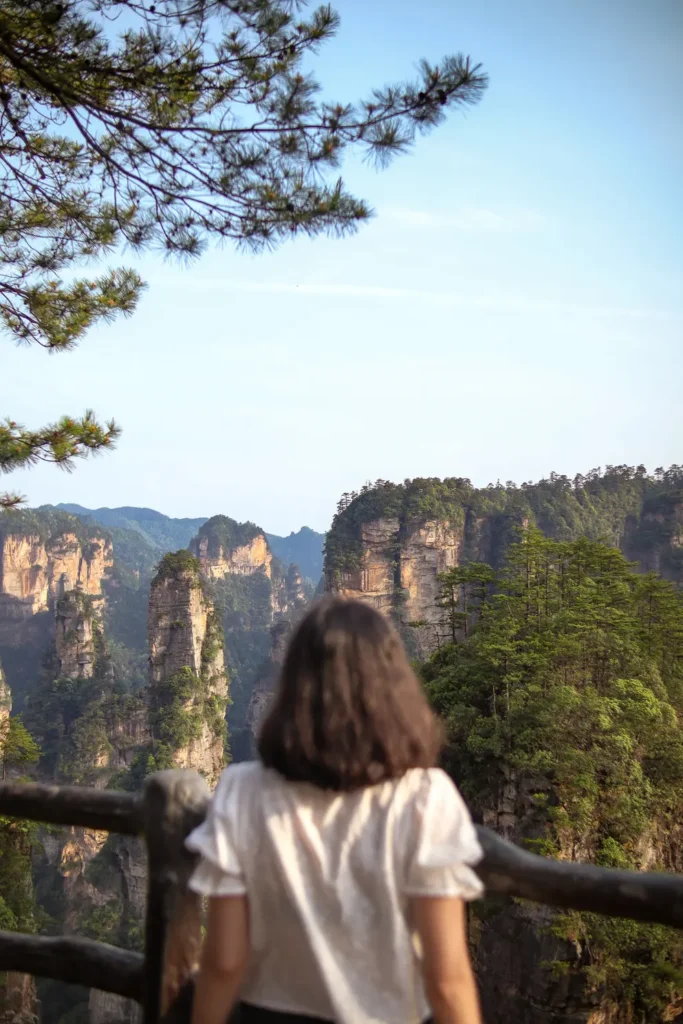
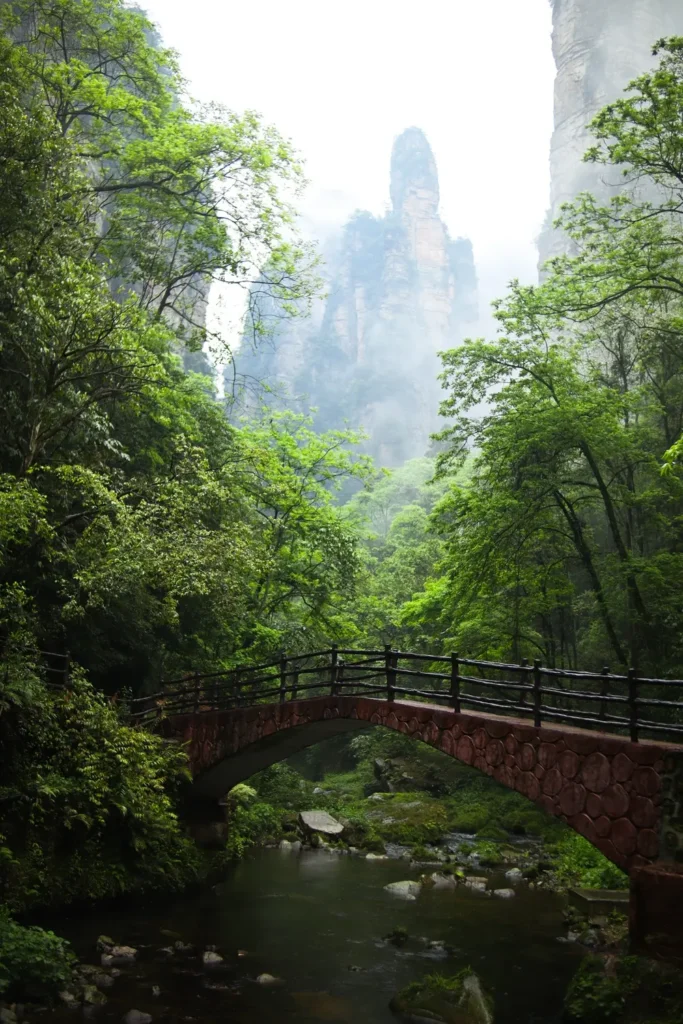
I’ll also clear up a common misconception. Most people think Tianmen Mountain and Zhangjiajie National Park are the same thing. They’re not. Tianmen Mountain is actually located in a different area, right above Zhangjiajie City. It requires a completely separate ticket and entrance.
So, I won’t be including it in this itinerary. But if you’re planning to visit both, don’t miss my detailed guide on how to visit Tianmen Mountain step by step. It covers all the routes, costs, and what to expect.
Here’s what you’ll find in this post:
- A step-by-step Zhangjiajie itinerary for 1.5 days
- Tips on park entrances, shuttle buses, and how to avoid wasting time
- A breakdown of the must-see areas: Yuanjiajie, Tianzi Mountain, Golden Whip Stream, and Ten Mile Gallery
- Helpful travel tips, personal reflections, and answers to the most asked questions
In a hurry? Plan your visit to Zhangjiajie now!
📍Top sights: Avatar Mountains (Yuanjiajie) | Tianzi Mountain | Bailong Elevator | Ten Mile Gallery | Golden Whip Stream
⌛ How long to spend in Zhangjiajie: 1.5 to 2 full days to see the main highlights
🎟️ Where to buy tickets: You can buy your tickets through WeChat, but I found Trip.com way more convenient, especially for international visitors.
1. Buy the park entrance ticket with shuttle buses
2. Buy your ticket for the Bailong Elevator
3. Buy your ticket for the Tianzi Cable Car
🚠 Recommended Route
Day 1: Yuanjiajie → Tianzi Mountain → Ten Mile Gallery
Day 2 (Half Day): Golden Whip Stream → Optional: Huangshi Village
😴 Where to stay: Wulingyuan town (I stayed at Bei’an Qingshe Holiday Inn—great location + comfy rooms)
💸 How to pay in China – It’s a cashless society. You’ll need Alipay or WeChat Pay to make purchases — literally everywhere. Use Revolut to pay in yuan and avoid foreign transaction fees.
💊 Best travel insurance for China – I recommend Heymondo for its excellent balance between affordability and quality.
🛜 Best way to stay connected in China – If your phone supports eSIM, use Airalo (MARIAN4315 = 3$ off). Otherwise, get a China Unicom or China Telecom SIM. Don’t forget a VPN to access apps like WhatsApp and Instagram.
How many days do you need in Zhangjiajie?
If you’re wondering whether it’s worth it to visit Zhangjiajie with limited time, absolutely yes. Even if you only have one day, you’ll still get to see some of the most jaw-dropping views in all of China.
Tickets to Zhangjiajie National Forest Park are valid for 4 consecutive days, but you don’t have to stay that long. I explored the park in 1.5 days and managed to hit all the must-see areas. This includes Yuanjiajie and Tianzi Mountain, including a ride up the epic Bailong Elevator—the world’s tallest outdoor lift.
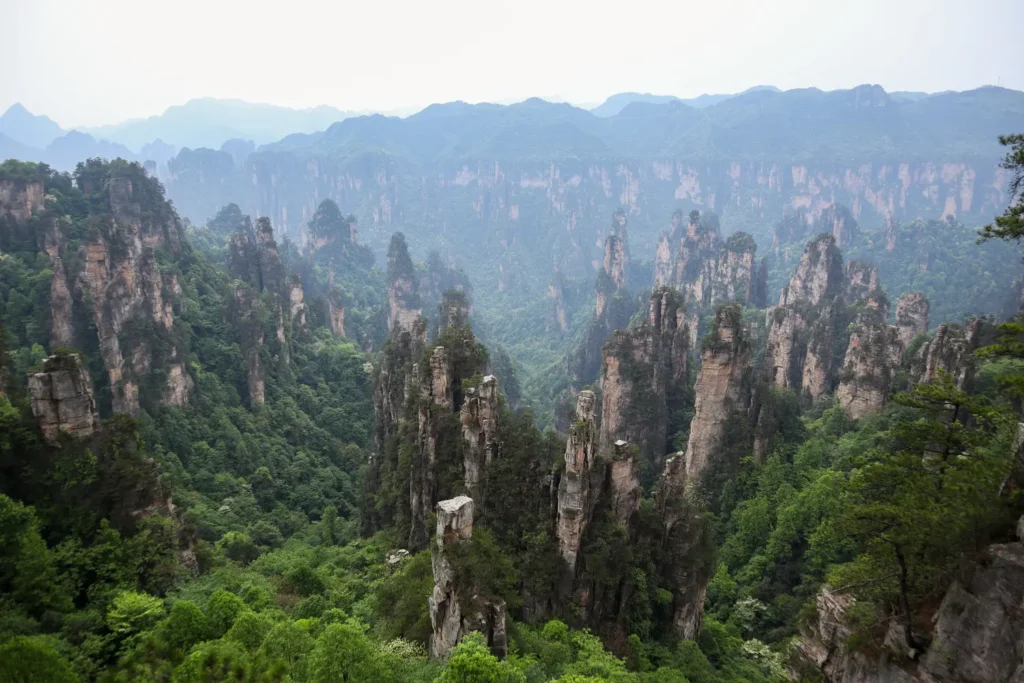
But keep in mind: the park is massive. You’ll need to plan well and move efficiently to make it work in a short timeframe. That’s where this Zhangjiajie itinerary comes in handy.
If you’ve got more time to spare, even better. In 3 to 4 days, you can explore other Zhangjiajie attractions like Yangjiajie, Huangshi Village, the Zhangjiajie Glass Bridge & Grand Canyon, or take a peaceful boat ride on Baofeng Lake.
Also, don’t confuse Tianmen Mountain with the national park—they’re two completely different places. You’ll need a separate ticket and entrance to visit it. For step-by-step info on Tianmen Mountain, check out my full guide on how to visit Tianmen Mountain.
Best time to visit Zhangjiajie
The best time to explore Zhangjiajie National Park is during spring (April–May) or autumn (September–October). These seasons usually bring mild temperatures, fewer crowds (just avoid national holidays), and clearer skies—perfect conditions to enjoy the views from the top.
Here are the average temperatures you can expect:
- Spring: 12°C to 22°C (54°F to 72°F)
- Summer: 20°C to 32°C (68°F to 90°F)
- Autumn: 10°C to 23°C (50°F to 73°F)
- Winter: -2°C to 8°C (28°F to 46°F)
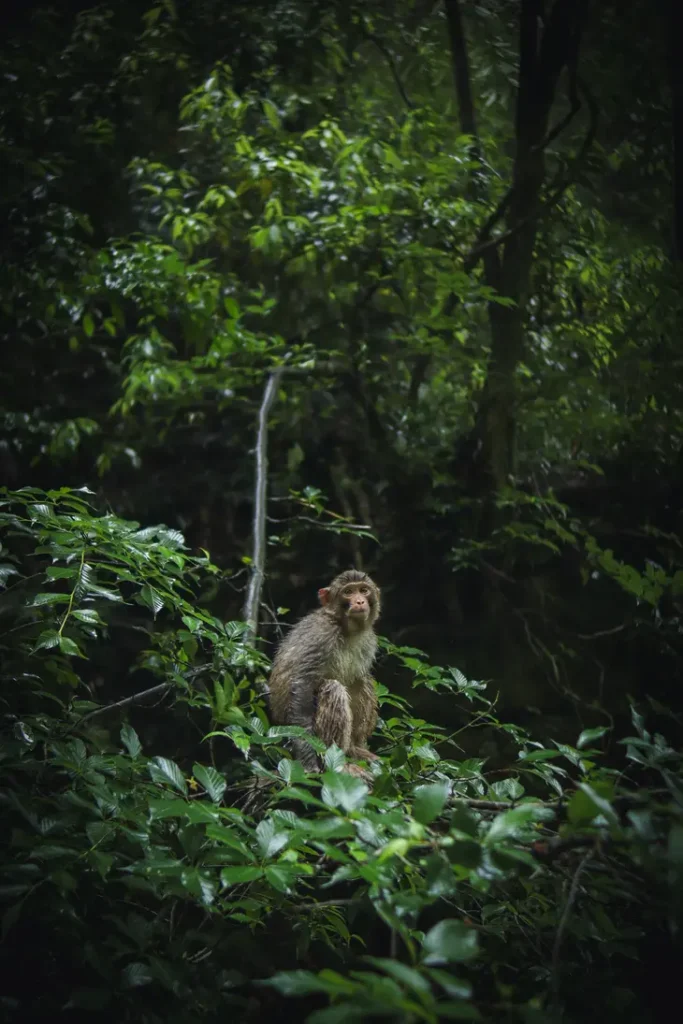
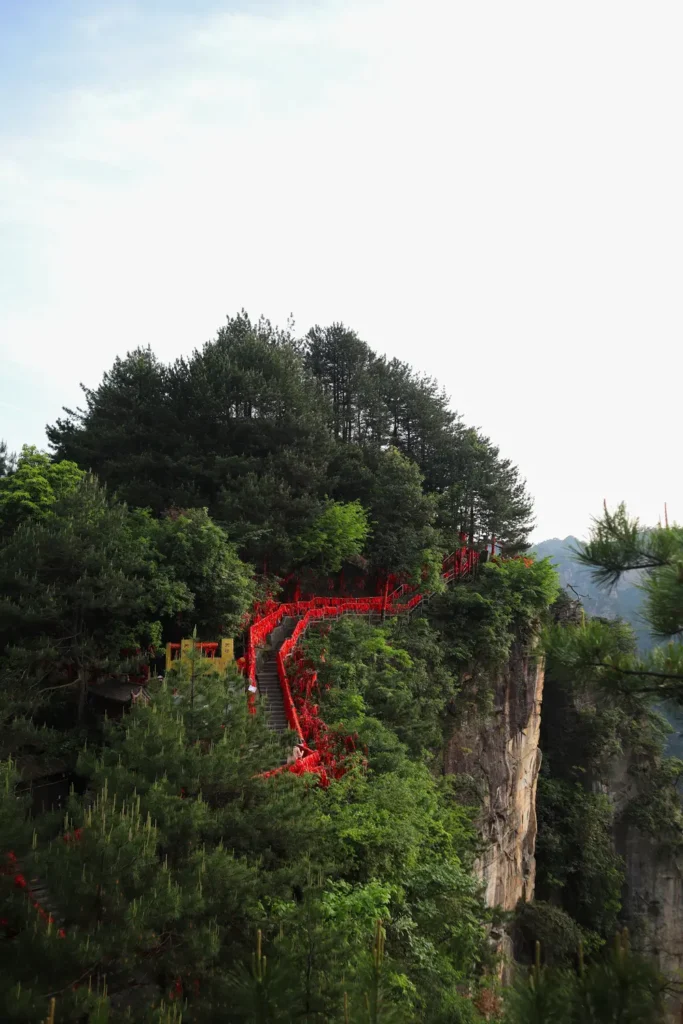
I went in late April, and overall, it was a good call. One day, the weather was gorgeous and the sunset was unreal. But the next day? Cloudy for most of the morning and it even rained in the afternoon. Still, I don’t regret a thing—it was a different vibe, but the experience didn’t feel any less special.
My tip? Try to visit the upper parts of the park when the skies are clear—places like Yuanjiajie and Tianzi Mountain are all about those wide views. I saved Golden Whip Stream and Ten Mile Gallery for when the forecast predicted rain, and that worked out well.
💼 TRAVEL INSURANCE: Unexpected events happen anywhere in the world, so I always recommend getting travel insurance. I regularly use Heymondo, which offers some of the highest coverages on the market at very competitive prices. As well as covering medical expenses, Heymondo’s insurance also covers the loss or theft of luggage, electronic equipment and more. They also have a 24/7 customer service through their App. As A Ticket to Take Off reader, you get a 5% discount when purchasing Heymondo insurance. The purchase must be made using this link, and the price shown on the website already includes the discount.
How to get to Zhangjiajie National Park
Despite the name, Zhangjiajie National Park isn’t actually in Zhangjiajie City. It’s about a 45-minute drive away.
The town of Wulingyuan is the best place to stay, especially if you want easy access to the park’s most iconic spots like the Avatar Mountains.
Getting to Zhangjiajie by plane
The nearest airport to Zhangjiajie is Hehua International Airport, located just outside the city. It’s connected to major hubs like Shanghai, Beijing, and Guangzhou.
I flew in from Shanghai with China Eastern Airlines, and the flight only took about 2 hours. It was super convenient and a great way to kick off my China adventure. Other airlines offer similar routes, so you’ll have plenty of options when booking.
Getting to Zhangjiajie by train
If you’re already traveling within China, high-speed trains are a solid choice.
You can reach Zhangjiajie West or Zhangjiajie Central Station from several nearby cities, including Changsha. It’s fast and usually more comfortable than long-distance buses.
Just a heads-up: Zhangjiajie has two train stations—Zhangjiajie Station and Zhangjiajie West Station. Double-check your arrival point to avoid confusion when planning transfers.
You can book train tickets through the official China Railway 12306 app, but I personally recommend using Trip.com. It’s much more user-friendly for international travelers and available in English.
Getting to Zhangjiajie by bus
Buses are really only a good idea if you’re coming from somewhere close.
Because of how vast China is, traveling by bus over long distances can be exhausting and time-consuming. If you can, stick to flights or high-speed trains—they’ll save you a lot of hassle.
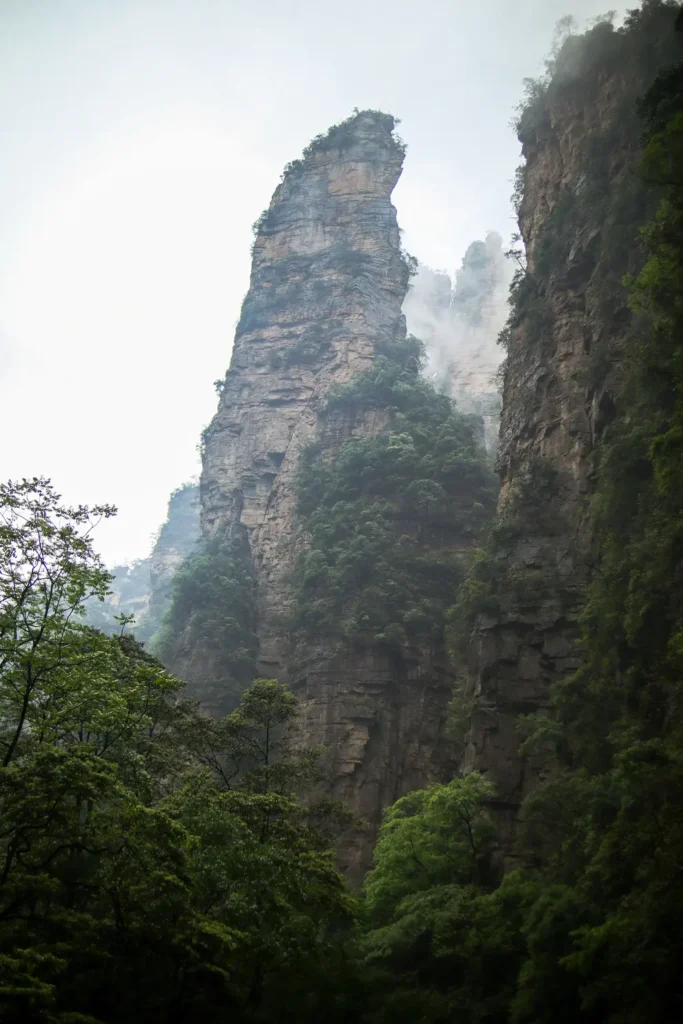
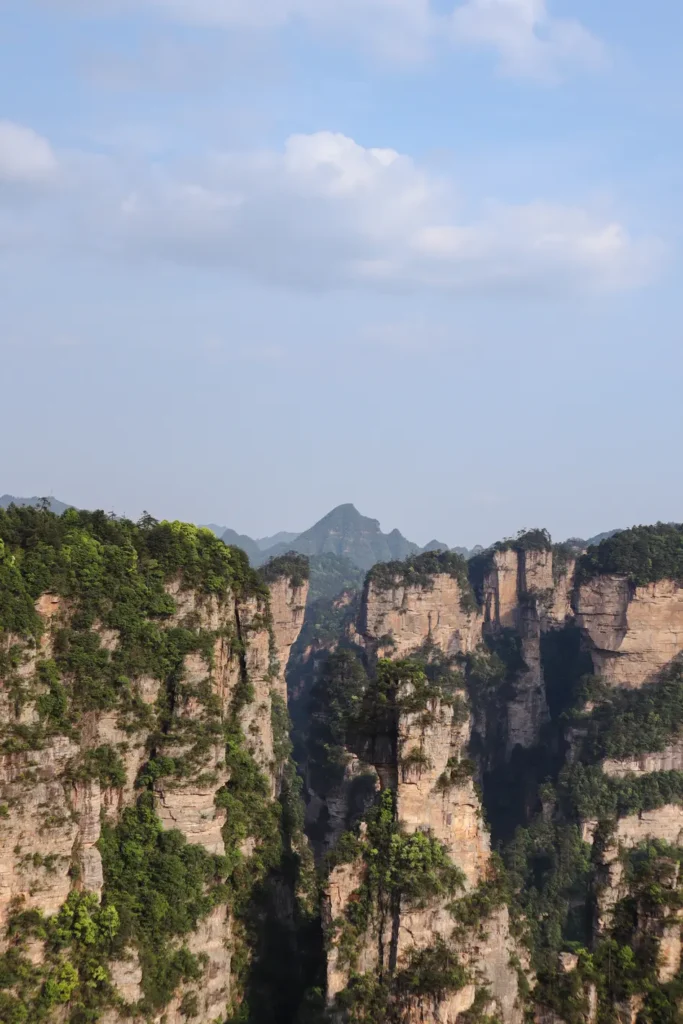
Once you land in Zhangjiajie or arrive at a train station, you’ll need to make your way to Wulingyuan:
- By Didi (Uber in China): Easy and inexpensive—expect to pay around 80 RMB (~10€) for the ride.
- By Bus: From Zhangjiajie West Train Station, the bus terminal is a 5-minute walk. Buses to Wulingyuan run regularly, cost 13 RMB (~1.6€) one way, and take about 45 minutes.
No matter how you get there, trust me—seeing China’s floating mountains in person is worth every mile.
Where to stay in Zhangjiajie
If you want to stick to a smooth Zhangjiajie itinerary and avoid wasting time on transport, where you stay really matters.
Don’t stay in Zhangjiajie City unless you’re only planning to visit Tianmen Mountain. You’ll end up spending way too much time getting in and out of the park each day.
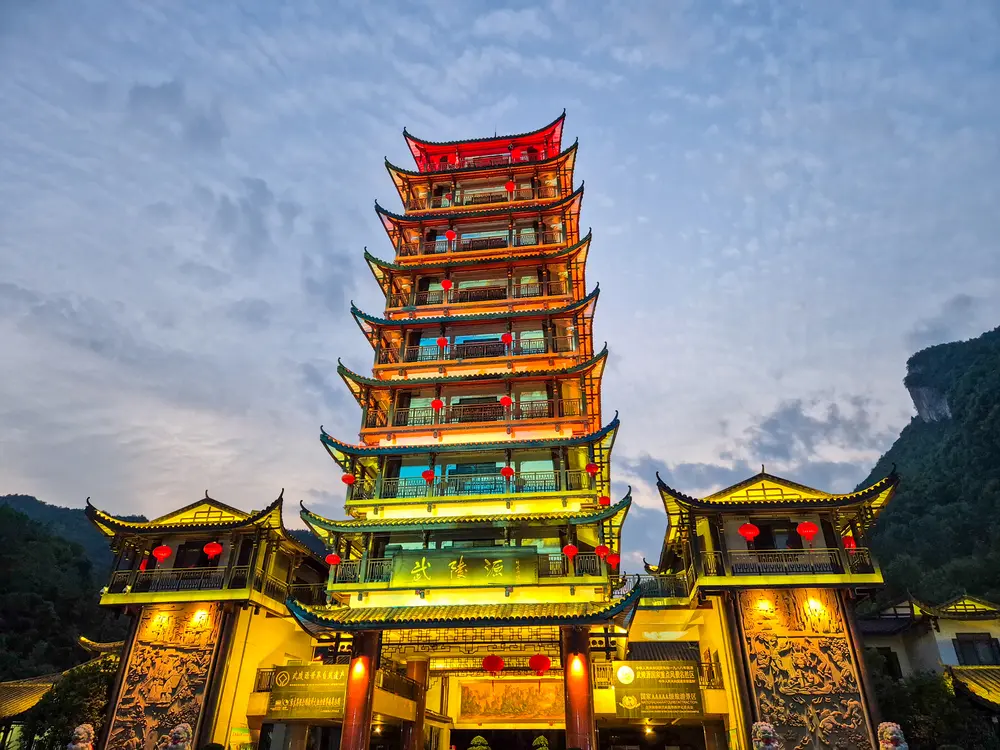
The best place to stay is Wulingyuan Town. It’s the closest base to Zhangjiajie National Forest Park, especially the East Gate (Wujiayu entrance). It’ll make your life way easier if you want to catch the park shuttles early in the morning.
Wulingyuan is rather a small town, but you’ll find plenty of hotels, minimarkets, and restaurants around.
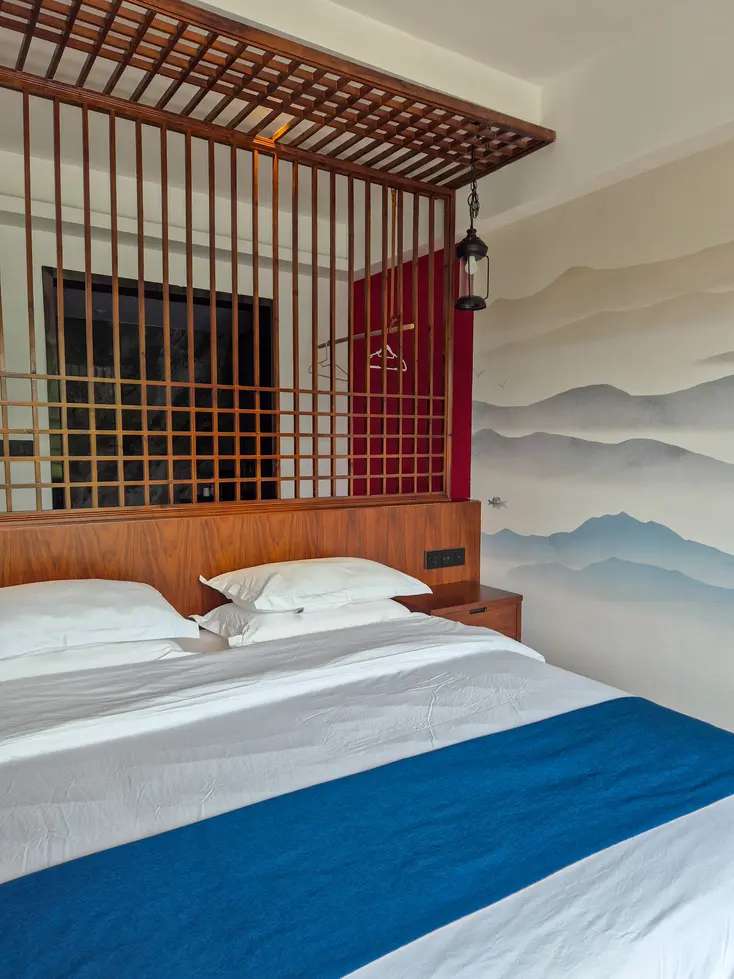
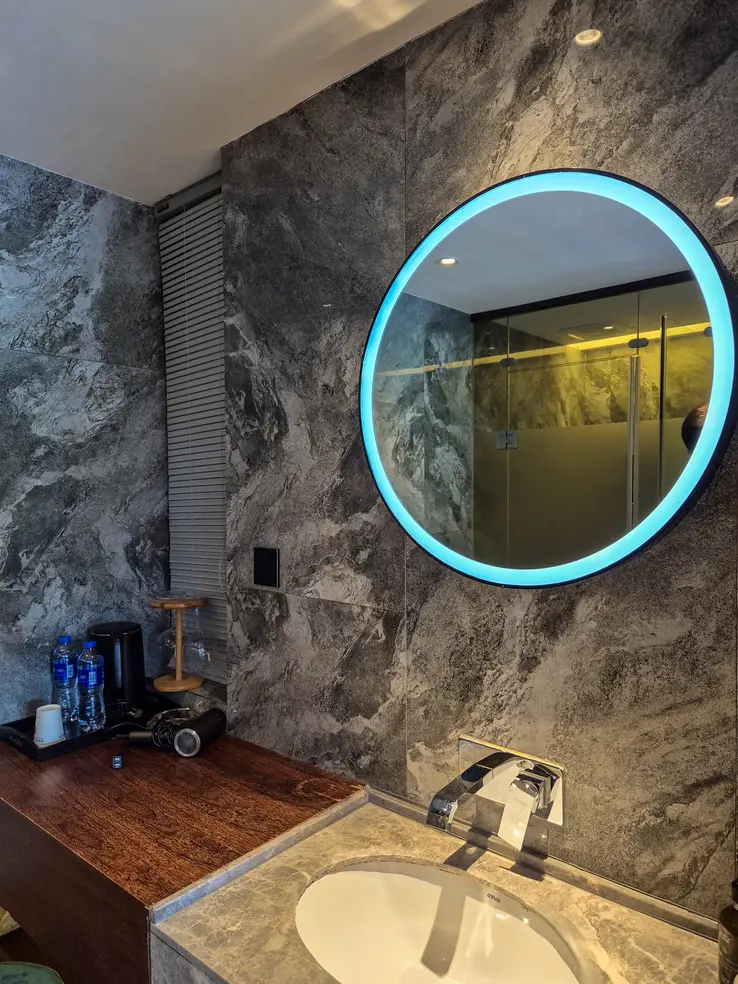
I stayed at Bei’an Qingshe Holiday Inn and totally recommend it. It was only about a 20-minute walk to the Wujiayu entrance, which is the main access point to the Avatar Mountains.
The rooms were spacious and comfy, and while the staff didn’t speak much English (very common in China), they were incredibly helpful.
However, here are some other options of accommodation in Wulingyuan:
Entry fees, Tickets & How to get around the park
You can buy your Zhangjiajie National Forest Park tickets through WeChat, but to be honest, I found Trip.com way more convenient.
The prices were basically the same, and it also allowed us to buy extras like the Bailong Elevator and the Tianzi Cable Car tickets in advance—so we didn’t have to figure it out once we got there.
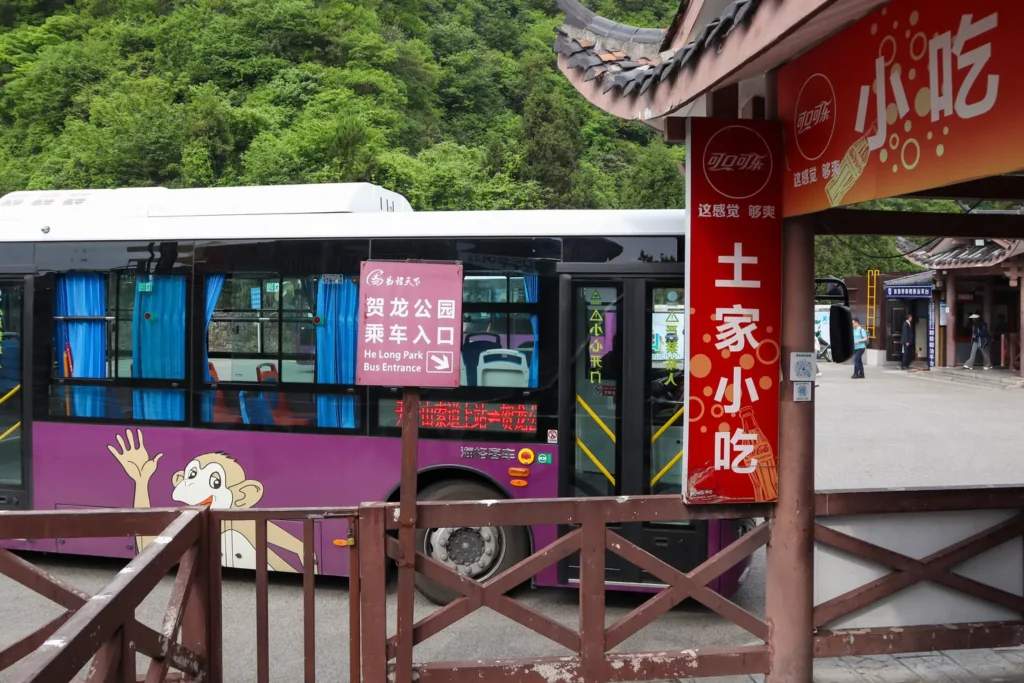
Just a heads-up! Zhangjiajie was one of the most expensive attractions I visited in China. The main park ticket isn’t too bad, but all the must-use extras like the cable cars and elevators add up quickly. Still, they’re totally worth it for the time and energy you save.
Here’s a quick cost breakdown based on the itinerary I followed:
- Park entrance ticket with shuttle buses (valid for 4 consecutive days): 225 RMB (27.5€) → buy your ticket for Zhangjiajie
- Bailong Elevator (one way): 65 RMB (7.9€) → buy your ticket for the Bailong Elevator
- Tianzi Mountain Cable Car (one way): 67 RMB (8.7€) → buy your ticket for the Tianzi Cable Car
- Ten Mile Gallery sightseeing tram (one way): 38 RMB (4.6€)
💡 EXTRA TIP: The park uses facial recognition for entry, so don’t forget your passport—it’s required to buy tickets and get in.
Zhangjiajie Itinerary
Let me give you a quick overview of how Zhangjiajie National Forest Park is laid out. Trust me, it’s easy to get confused if you don’t understand the structure.
The park is divided into two main sections. The upper area (where you’ll find the dramatic mountaintop views like Yuanjiajie and Tianzi Mountain) and the lower area (which includes scenic valley walks like Golden Whip Stream and Ten Mile Gallery).
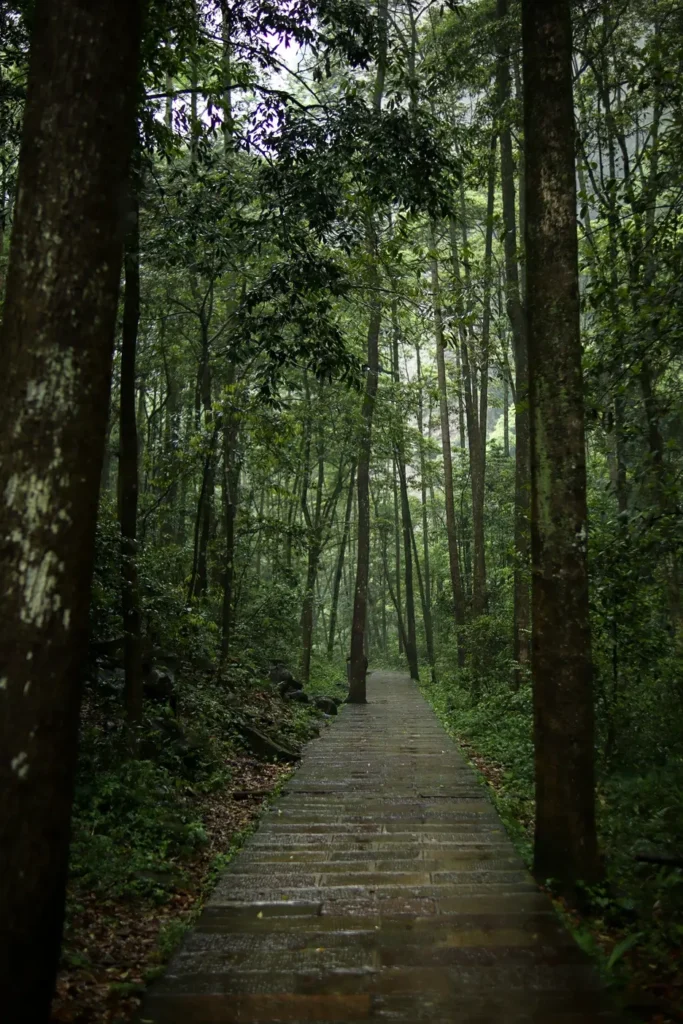
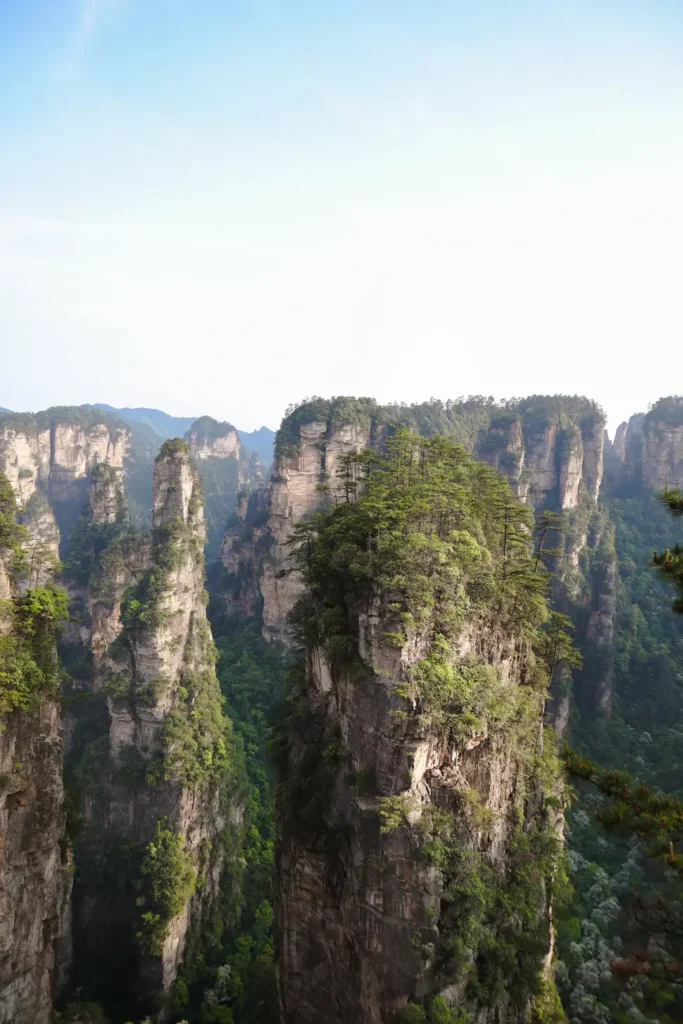
These sections are connected by shuttle buses, elevators, and cable cars—but not directly by bus—so getting around takes a bit of planning.
In this 1.5-day itinerary, we’ll focus on the most iconic viewpoints and areas. This includes the Avatar Mountains (Yuanjiajie), Tianzi Mountain, and the trails of Ten Mile Gallery and Golden Whip Stream.
The only area we’ll be skipping is Yangjiajie (easily confused with Yuanjiajie because of the similar name). This is a separate section known for steeper, more rugged trails.
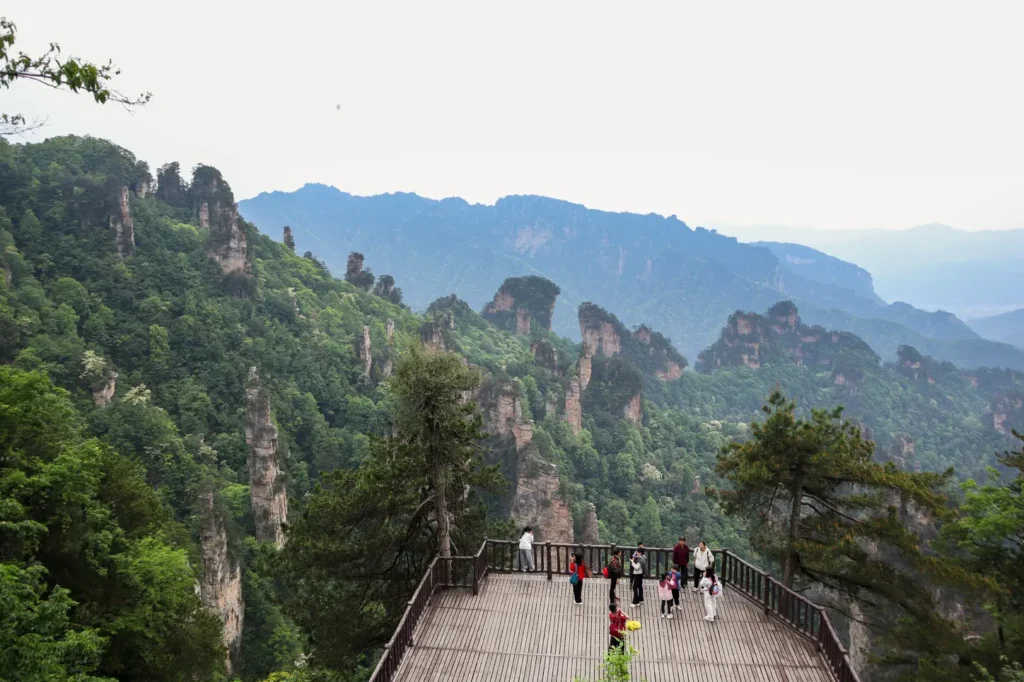
This itinerary also doesn’t include other nearby attractions like Tianmen Mountain, Baofeng Lake, Yellow Dragon Cave, or the Zhangjiajie Glass Bridge & Grand Canyon. These spots are not part of the national park and each requires a separate ticket. So, if you have more time, they could be great add-ons.
I didn’t follow this exact order during my trip because of weather constraints. But, after experiencing the park, I can confidently say this is the most time-efficient and cost-effective Zhangjiajie itinerary.
Day 1: Yuanjiajie + Tianzi Mountain + Ten Mile Gallery
To make the most of your time, start early—ideally before 7 am.
Enter the park through the Wujiayu Ticket Station, which is about a 25-minute walk from most accommodations in Wulingyuan town.
This entrance gives you direct access to the park’s most famous viewpoints and is a great starting point for your Zhangjiajie itinerary.
» Yuanjiajie/Avatar Mountains (2h-3h)
From the entrance, hop on a shuttle bus to the Bailong Elevator, which takes around 35 minutes. Just a heads-up: before reaching the actual Bailong Elevator, you’ll need to ride an initial elevator. It’s not clearly signed, so it can be a little confusing—don’t be shy about asking staff or pointing to your map if needed.
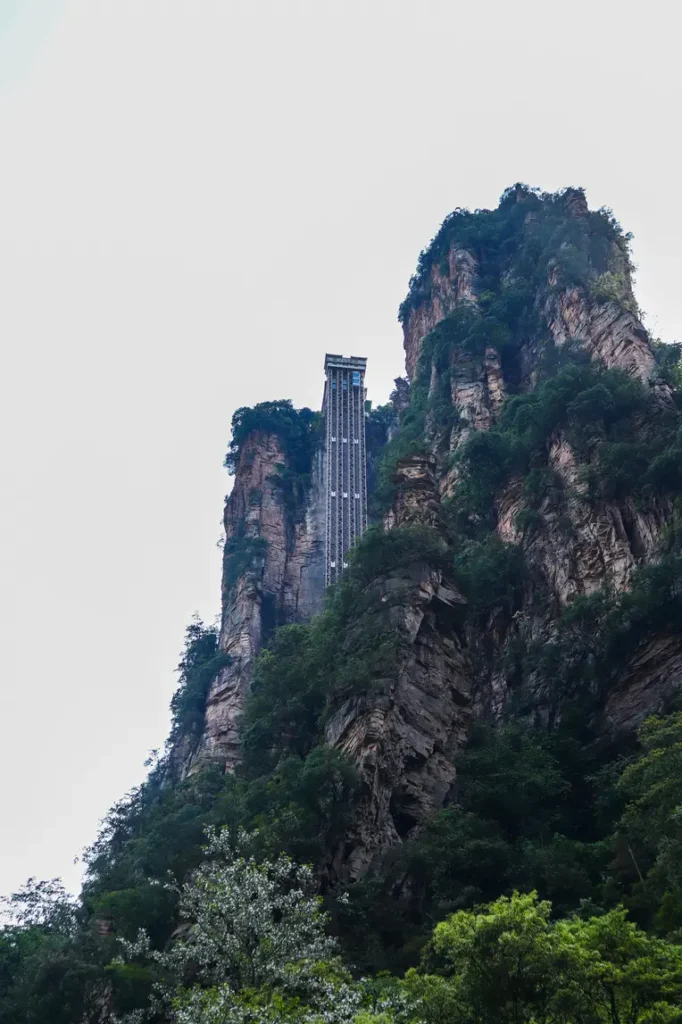
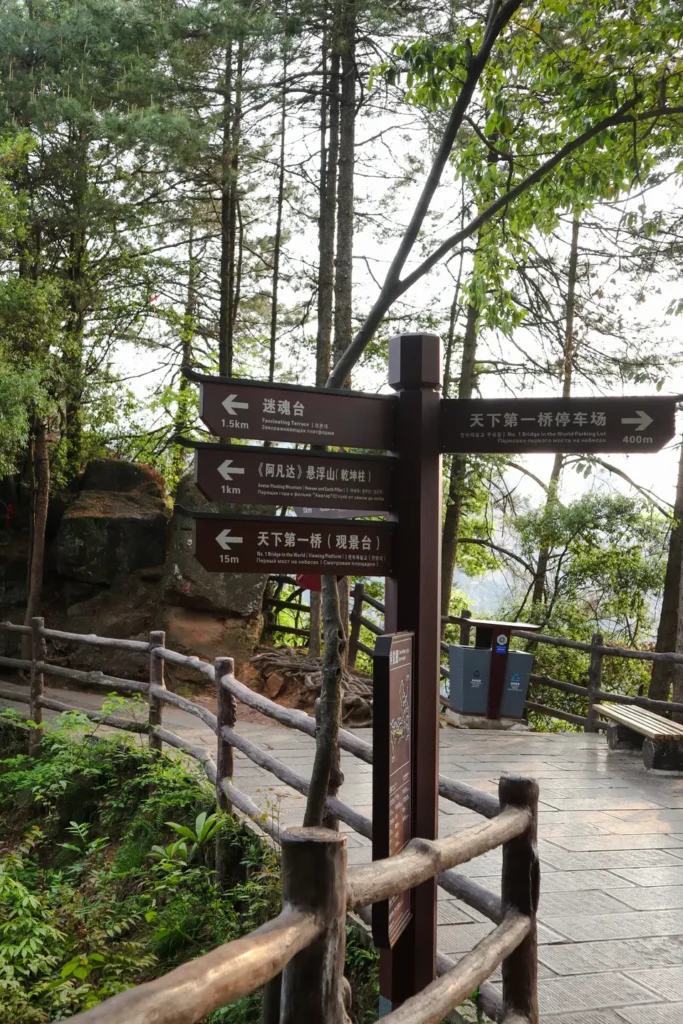
The Bailong Elevator is one of the park’s most iconic experiences (tickets sold separately). It’s the tallest outdoor elevator in the world, climbing 326 meters up the cliff face in under 2 minutes. It’s made entirely of glass, so if you can, try to snag a spot near the windows for some jaw-dropping views as you rise above the valley.
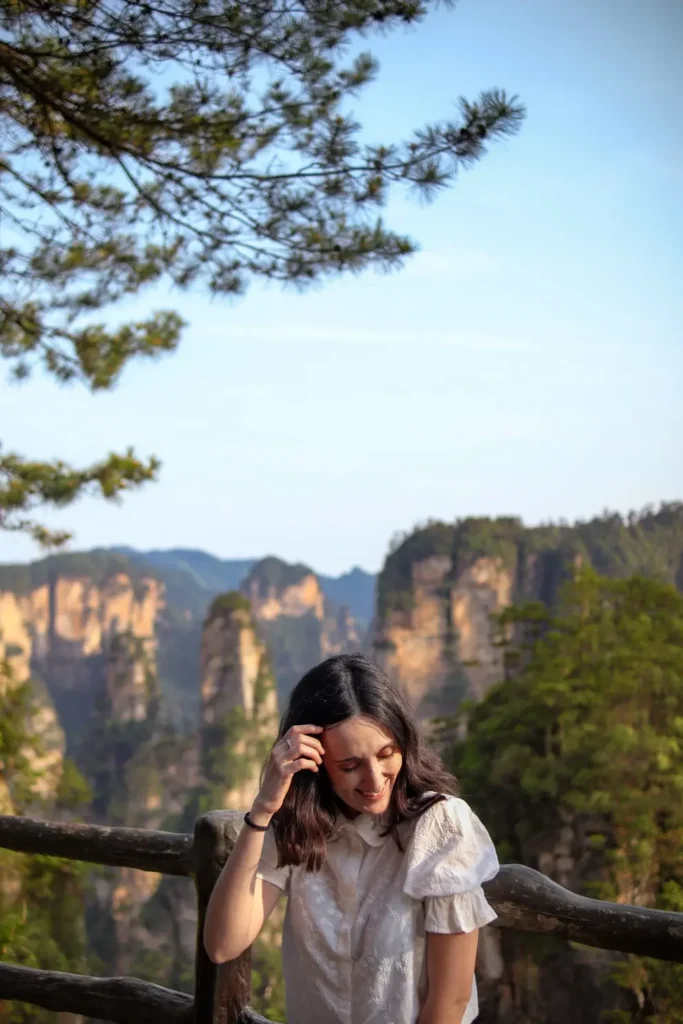
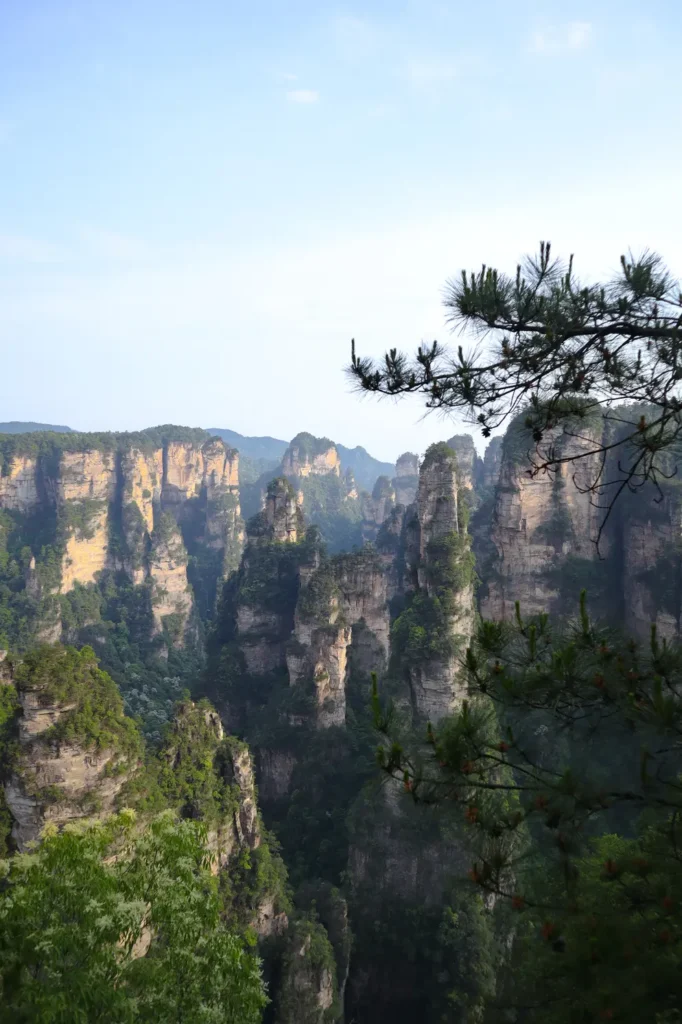
That said, it gets very crowded, especially in the morning. Expect to queue and be ready to nudge your way to the front if you want the best view.
Once at the top, you’ll find yourself in the heart of the Avatar mountains. These dramatic sandstone pillars inspired the floating mountains in James Cameron’s Avatar. That’s exactly why this section of the park is so famous.
And honestly? Even if you’ve never seen the movie (guilty!), it’s still one of the most impressive landscapes you’ll ever see. The way the peaks rise straight out of the mist makes the whole place feel otherworldly.
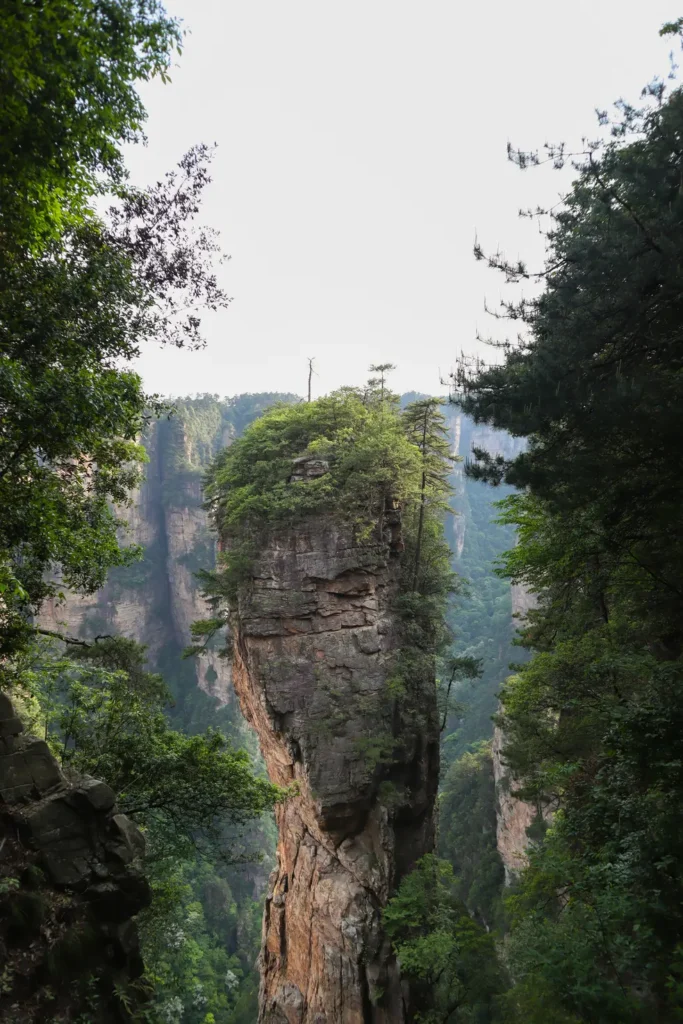
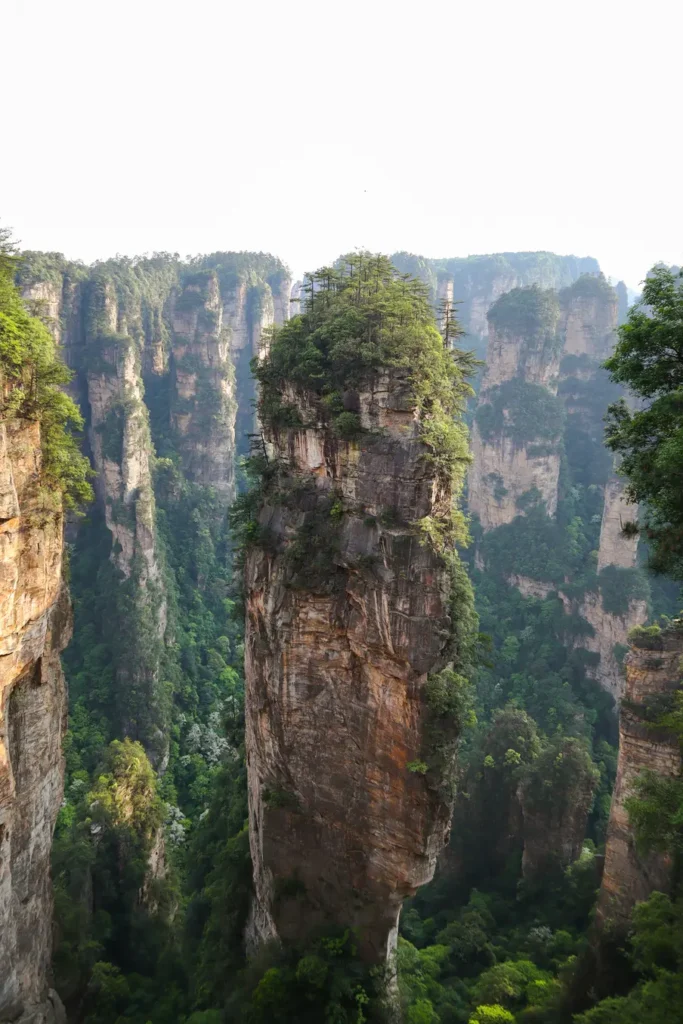
You’ll spot some of the most iconic rock formations in Zhangjiajie here, so keep your camera close.
From Bailong, take the shuttle to the Enchanting Platform (迷魂台).
Don’t worry about getting lost. Once you’re here, it’s easy to find your way around. There are maps scattered throughout the area. They include both Chinese and English names, which makes navigating much less stressful.
The main highlights in Yuanjiajie include:
- Hallelujah Mountain (哈利路亚山 / Southern Sky Pillar) – the real-life version of the floating mountains from Avatar
- First Bridge Under Heaven (天下第一桥) – a natural stone arch between two towering cliffs
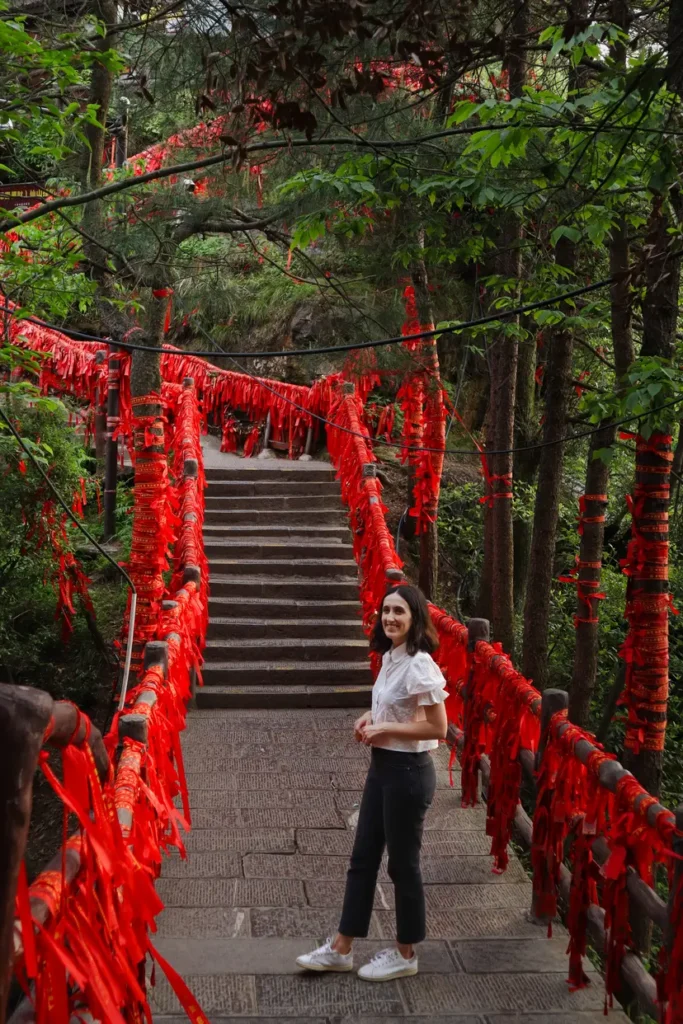
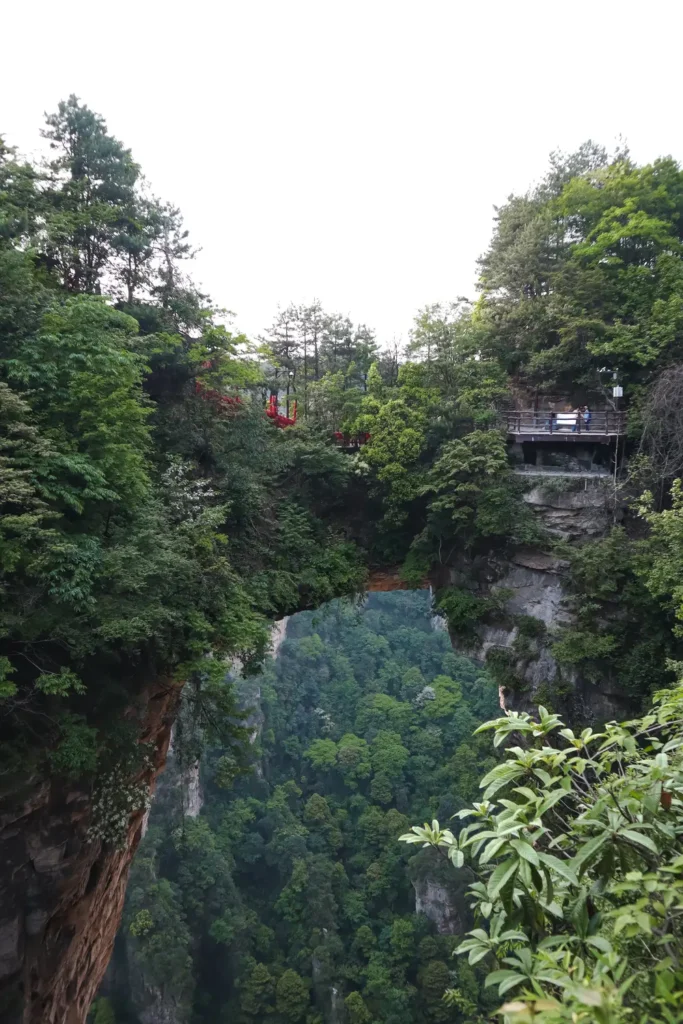
The area around Yuanjiajie is mostly flat, with short walks connecting each viewpoint. If you’re short on time but want those once-in-a-lifetime views, this is still one of the best Zhangjiajie hikes to include in your itinerary.
» Tianzi Mountain (2 hours)
After finishing up at First Bridge in Yuanjiajie, hop on a shuttle bus to Helong Park (贺龙公园). This will be your starting point for exploring Tianzi Mountain.
It’s one of the highest areas in the park and offers sweeping views of the surrounding sandstone peaks, when the weather cooperates.
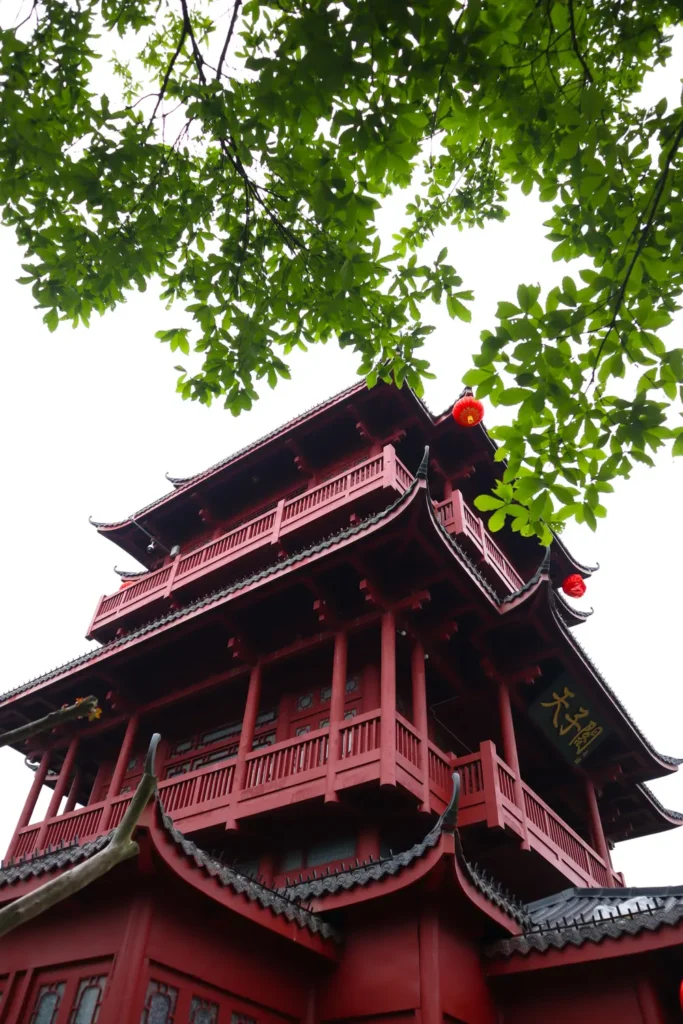
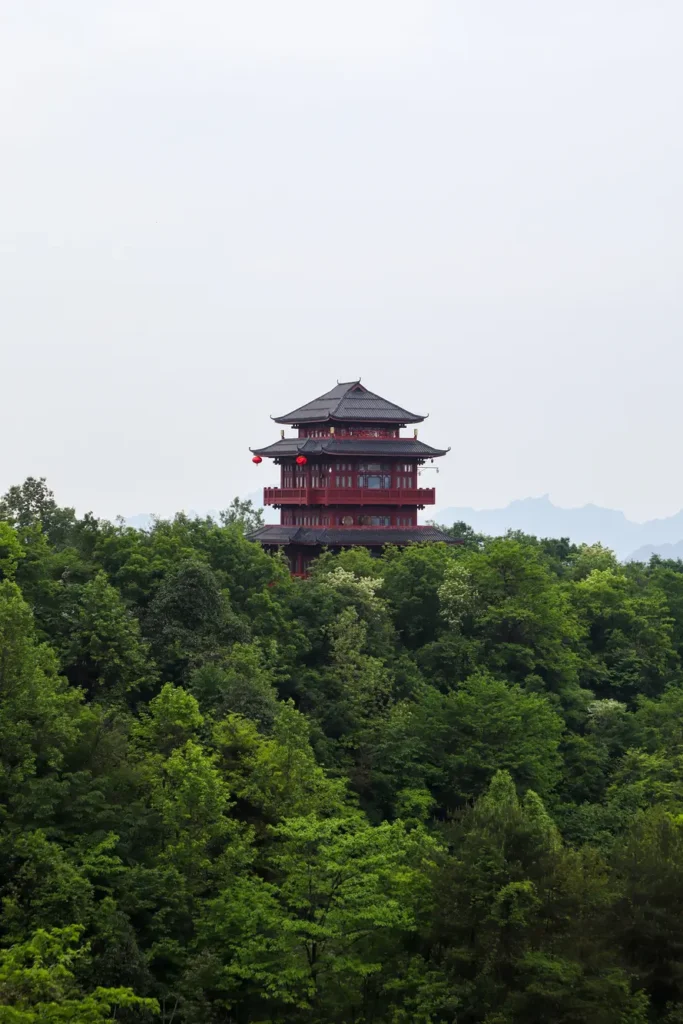
There are several incredible viewpoints in this part of the park (e.g. Tianzi Viewing Platform, Imperial Writing Brushes Peaks, or Fairy Dispersing Flowers).
Tianzi Pavilion (天子阁) is one of the top viewpoints in the area and sits at the highest observation deck on Tianzi Mountain. It’s an easy walk from Helong Park and offers panoramic views—on a clear day, that is.
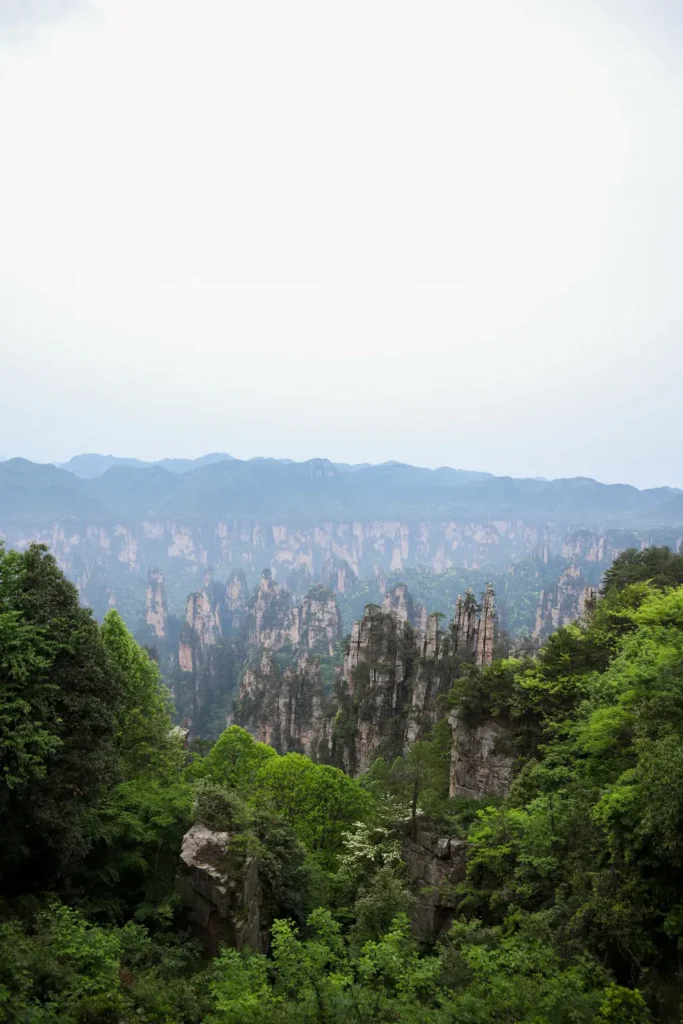
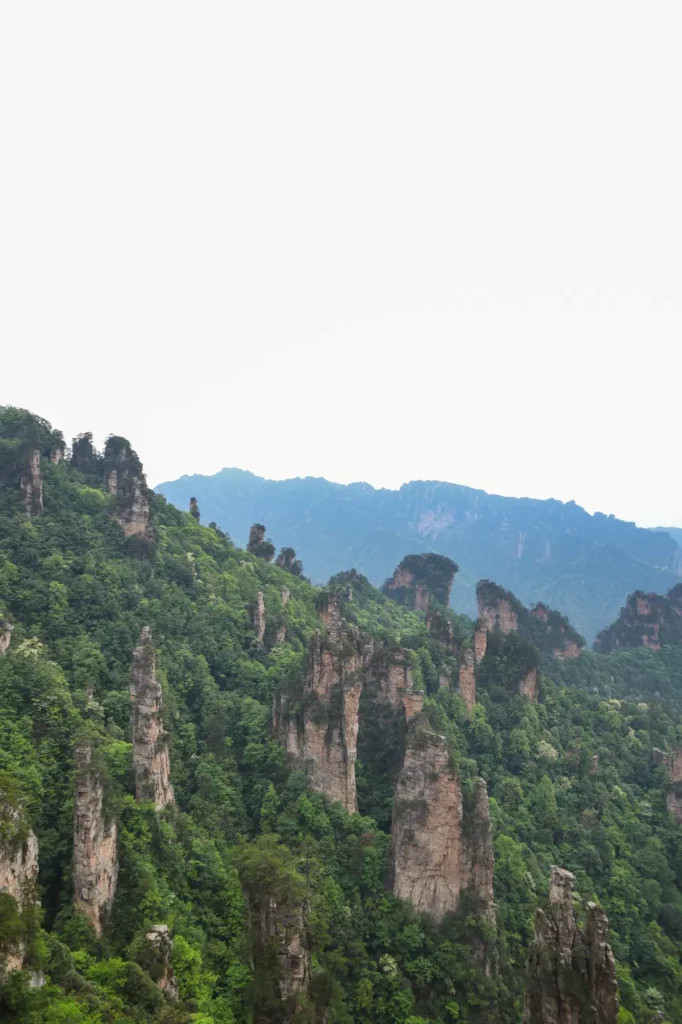
We also tried to make it to Dianjiang Terrace (点将台), another popular lookout spot, but had to skip it due to bad weather.
If you have a bit more time and don’t mind a small detour, consider visiting Fields in the Air (空中田园). It’s a scenic mountaintop farmland with terraced views
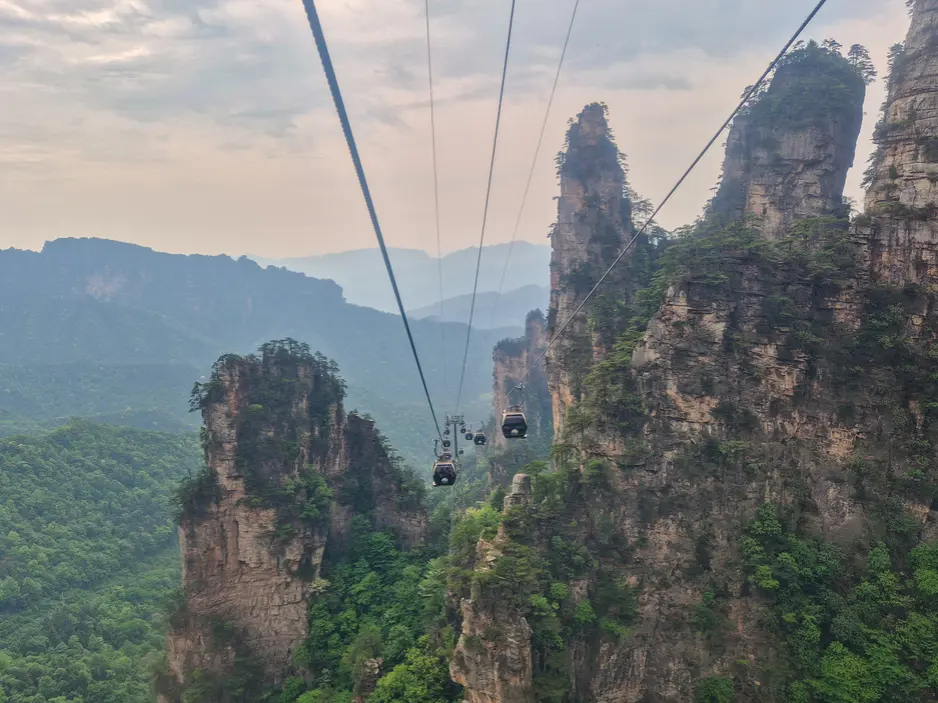
When you’re ready to leave, catch a shuttle bus to the upper station of the Tianzi Mountain Cable Car. From there, you can take the cable car down (ticket sold separately). The ride is stunning on a clear day as it glides past the peaks and forests below.
I visited during foggy weather, and although it still had its charm, I didn’t find it as striking as other parts of the park—possibly because the views were mostly hidden behind clouds.
💡 EXTRA TIP: The shuttle system can be really confusing, especially the first time you use it. I highly recommend grabbing a map at the entrance. It helped me so much when figuring out where to go. Since most park staff don’t speak English, pointing to the stop on your map is the easiest way to ask for help before boarding the wrong shuttle.
» Ten Mile Gallery (1 hour)
To wrap up the day, head to the Ten Mile Gallery area, which you can reach by shuttle from the lower Tianzi cable car station. This part of the park feels completely different—and honestly, it’s also one of the most entertaining.
You’ll board a tram decorated with cute animal characters. It might look a little silly at first, but I have to admit—it was fun.
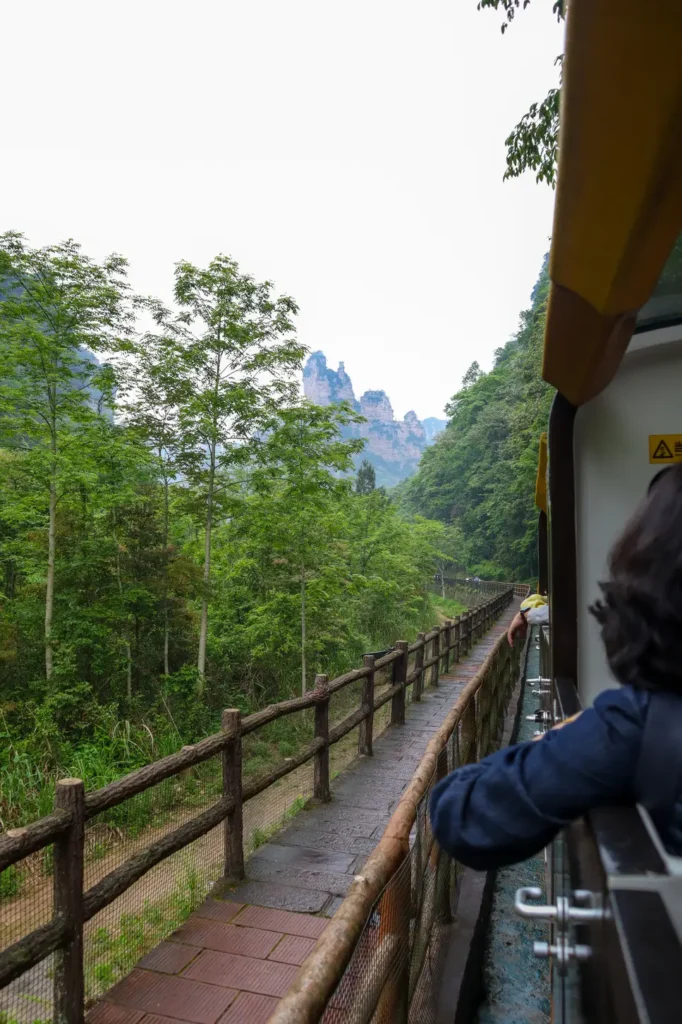
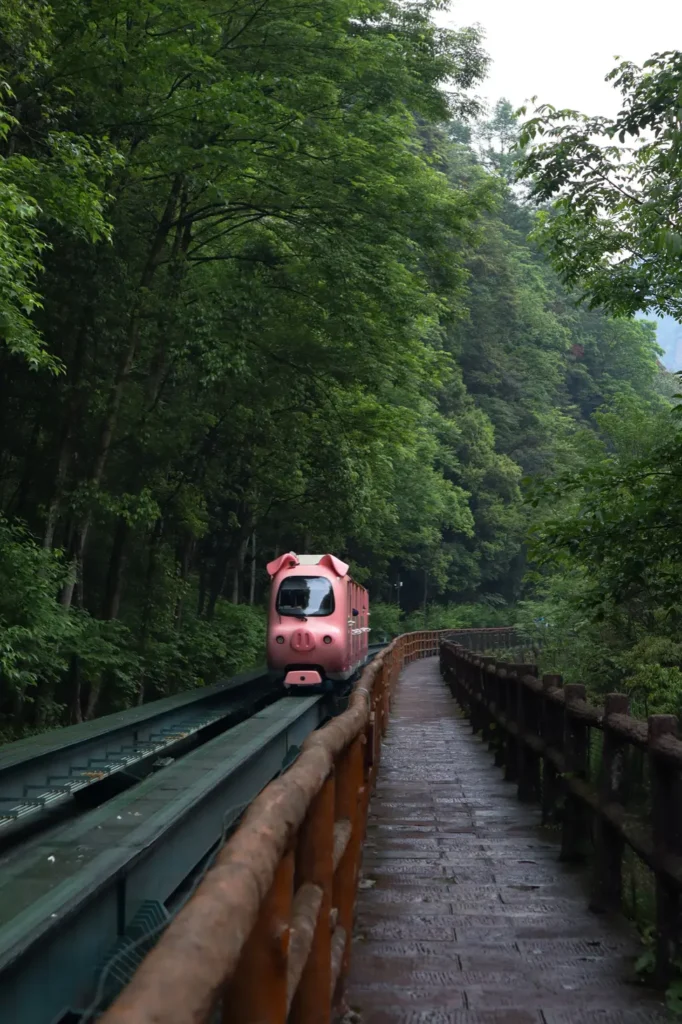
The full visit took us about an hour, including a 10-minute ride up, 10 minutes at the end, and about 40 minutes walking back with lots of photo stops.
The trail is 5.8 km (3.6 miles) round-trip. But if you’re on a budget, you can absolutely walk the whole thing. The best combo, in my opinion, is to take the tram up (it’s a bit uphill) and then walk back down at your own pace. It’s a gentle and scenic trail, making it one of the most relaxing Zhangjiajie hikes you can do.
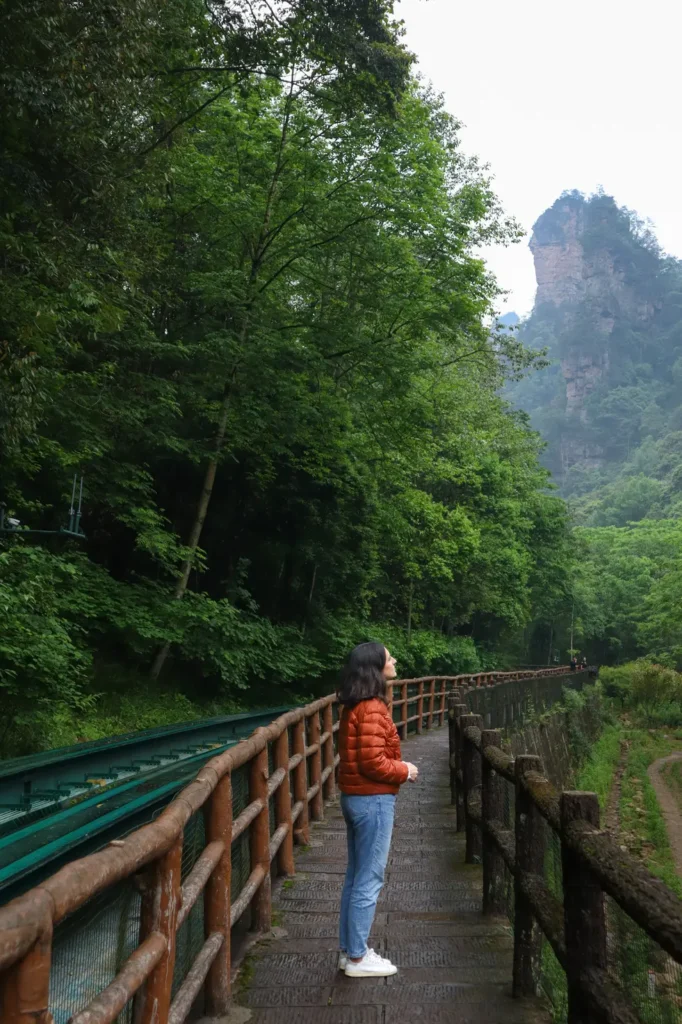
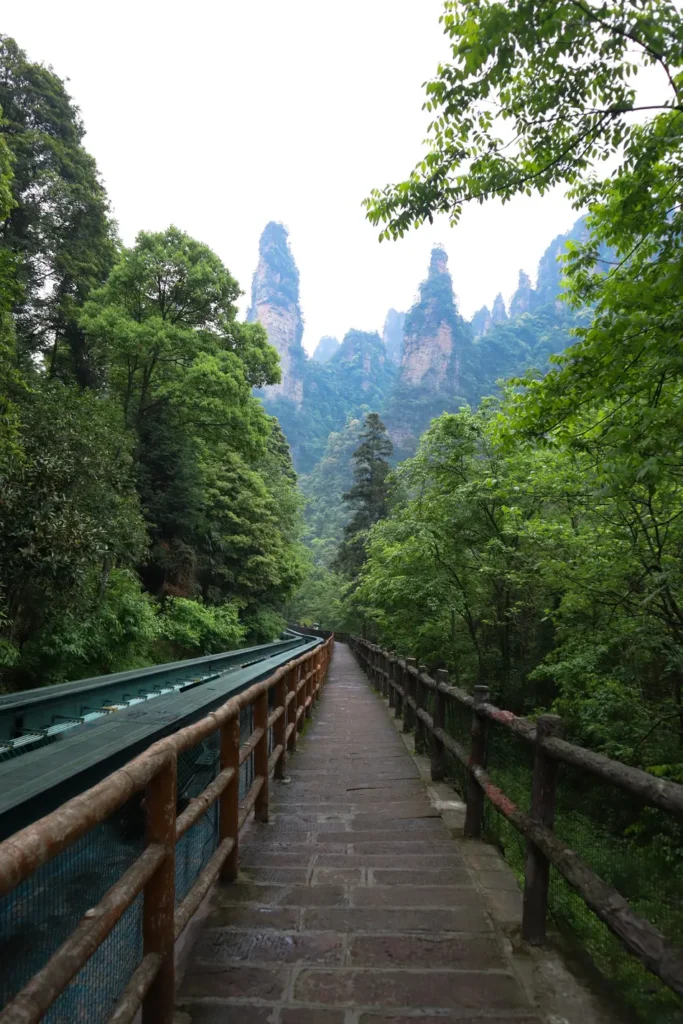
Along the trail, look out for:
- Three Sisters Peak (三姐妹峰) – three distinct pillars standing side by side
- Old Man Gathering Herbs (采药老人) – shaped like a man carrying a basket
- Monkey Garden – a designated area where monkeys roam freely. I didn’t love this part; there weren’t many monkeys around when I visited.
After the hike, take the shuttle back to the East Gate and head back to Wulingyuan town and get some well-deserved rest.
Day 2 (Half Day) – Golden Whip Stream Hike (3 hours)
For your second day in Zhangjiajie, start early again and enter through the Wujiayu Ticket Station (East Gate).
This time, take the shuttle to Water Winding Four Gates (水绕四门)—the starting point of the Golden Whip Stream trail.
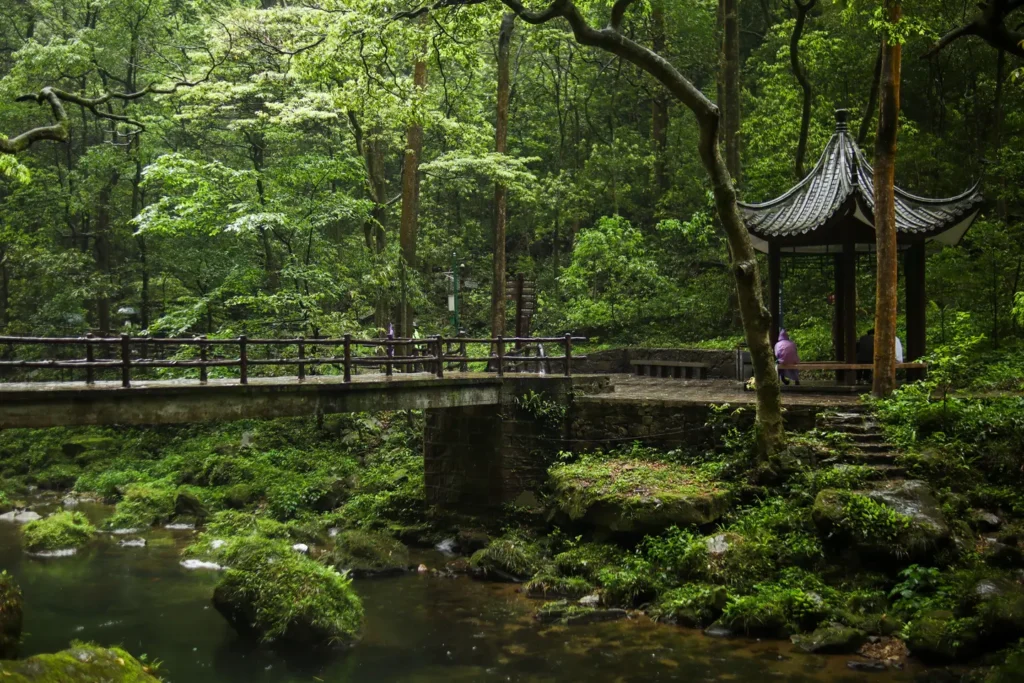
This is one of the most peaceful areas of the park. The 7.5 km (4.7 mi) trail winds through a lush canyon, following a stream at the base of towering cliffs.
It’s a relaxing walk with mostly flat terrain, perfect for a slower-paced morning. You’ll be surrounded by greenery, dramatic stone walls, and occasional rock formations that make it feel like a real-life storybook setting.
Along the way, keep an eye out for:
- Golden Whip Rock (金鞭岩)
- Zicao Pool (紫草潭)
- Rock of Splitting the Mountain to Save Mother (劈山救母)
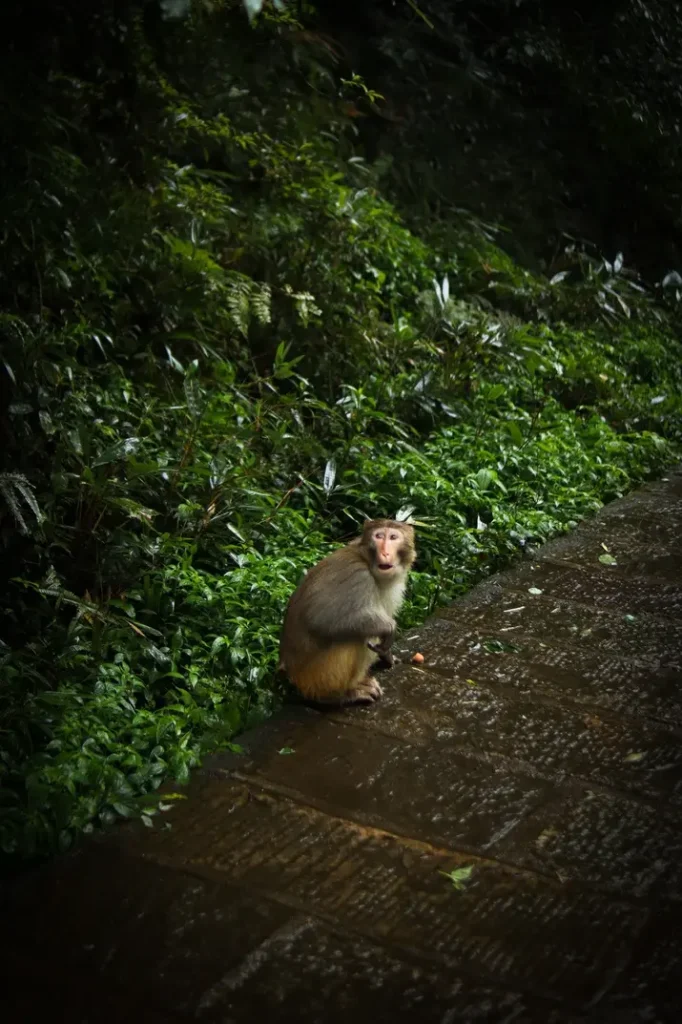
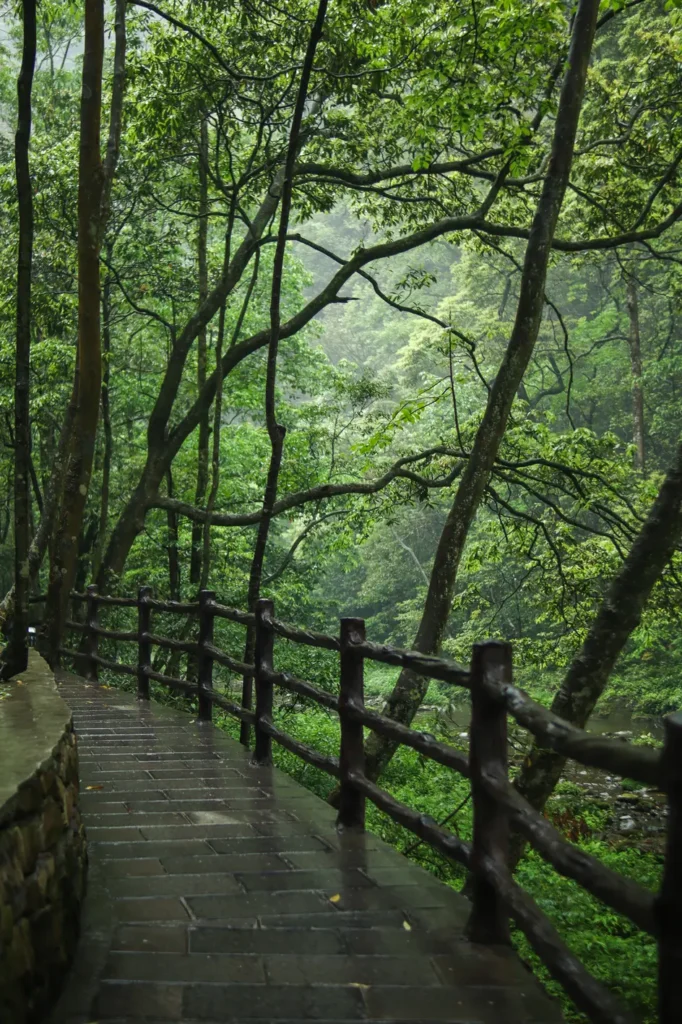
I had read that this trail is full of wild monkeys, but I honestly only saw two the entire time—maybe because it was raining.
That said, I still really enjoyed the trail. It’s a beautiful and quiet part of the park, especially compared to the chaos of Yuanjiajie.
Though I’ll admit, I was pretty tired when I did this trail and by the last stretch, I just wanted it to be over. The trail does start to feel a bit repetitive toward the end, so I think it could be a little shorter.
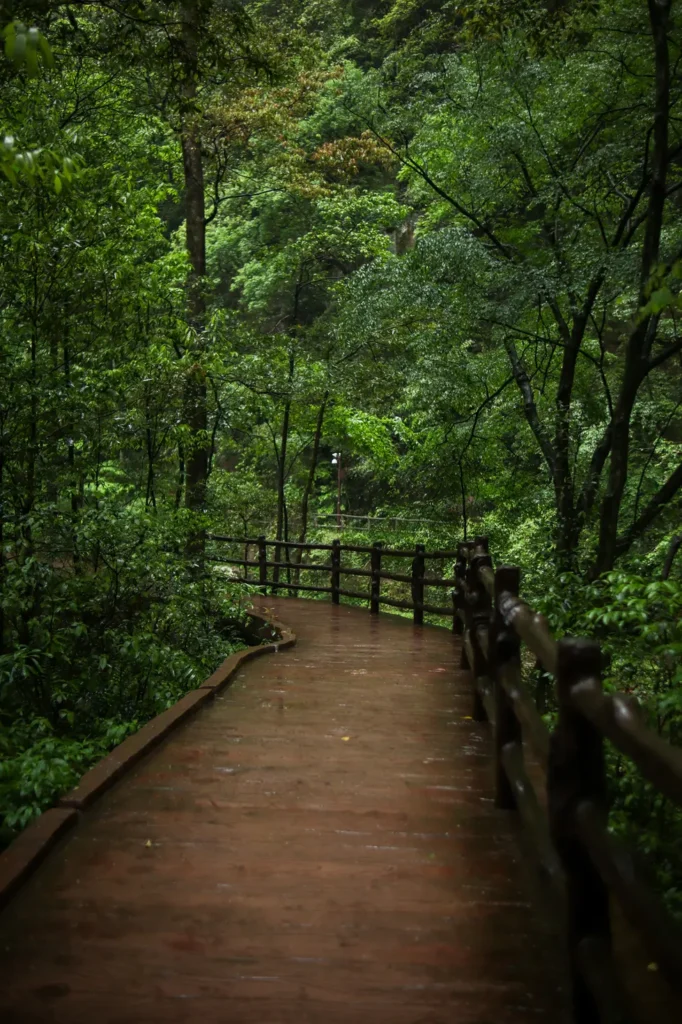
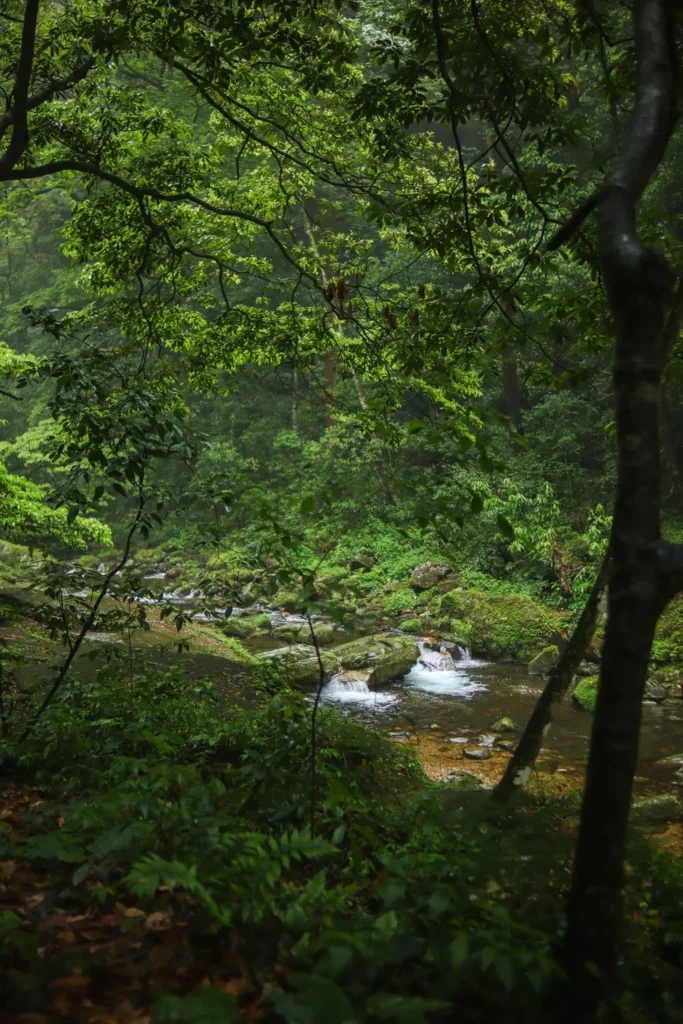
The best part? You exit at the Zimugang (South Gate), which means no need to backtrack. From there, you can easily take a local bus or a Didi back to Wulingyuan—our Didi cost about 5€ and took around 30 minutes.
💡 EXTRA TIP: If you have extra time after finishing the Golden Whip Stream trail, consider heading to Huangshi Village. Despite the name, it’s actually a mountaintop hiking trail, not a real village—and it offers some seriously stunning views. The easiest way to visit is to take the cable car up (extra ticket required) and hike back down along the loop at the top. To get there, just hop on a shuttle bus at the end of the Golden Whip Stream trail—it’ll take you straight to the lower cable car station.
Other tips for visiting Zhangjiajie National Park
- Go early to beat the crowds—especially if you plan to use the Bailong Elevator or Tianzi Mountain Cable Car, which are two of the most popular attractions and can get packed quickly.
- Avoid Chinese national holidays at all costs. I visited China during the Labour Day holidays, and even though I wasn’t in Zhangjiajie at the time, other cities were overwhelming. The crowds were intense, and the experience wasn’t the greatest.
- Dress in layers. It’s usually chilly in the early morning, but it warms up fast as the day goes on, especially with all the walking.
- Don’t stress about food. There are plenty of places to eat inside the park, including a McDonald’s. Unless you’re on a tight budget, there’s no real need to bring your own food.
- Expect a lot of walking and stairs. Seriously, your legs will feel it—but every step is worth it.
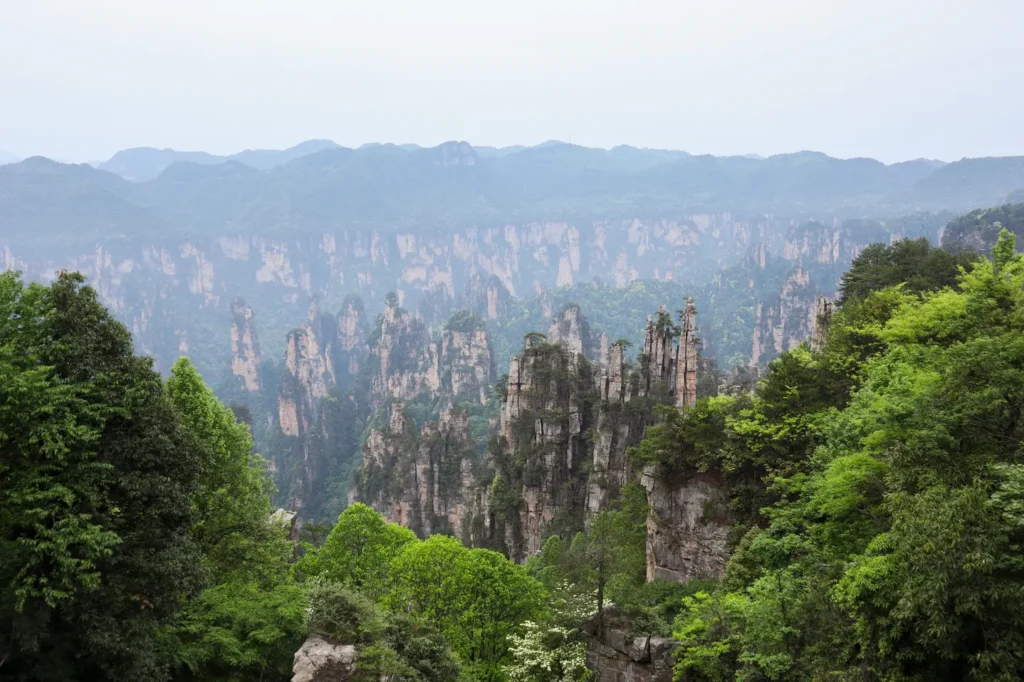
- Bring your passport. You’ll need it to buy your ticket and enter the park—it works as your entry ID thanks to facial recognition.
- No shuttle connects the upper and lower sections of the park. To move between levels, you’ll need to take the Bailong Elevator, or the cable cars at Tianzi Mountain or Yangjiajie.
- The park opens at 7 am and closes around 7 pm, but make sure you check the last departure times for shuttle buses, cable cars, and the Bailong Elevator. Getting stranded inside the park isn’t how you want to end the day.
- Toilets are available throughout the park, but bring tissues and hand sanitizer—just in case.
- Beware of monkeys, especially near Golden Whip Stream. They can get aggressive if they see food.
- There are five park entrances. The two most commonly used are Wulingyuan Entrance (East Gate) – ideal if you’re staying in Wulingyuan and Zimugang Entrance (South Gate) – the exit point for Golden Whip Stream.
Other places to visit if you have more time near Zhangjiajie National Park
Baofeng Lake
If you’re looking for something relaxing, Baofeng Lake is a nice add-on. It’s a calm boat ride through a scenic canyon, with steep cliffs rising on both sides. The setting is beautiful, but the vibe is a little staged—still, it’s a good break from all the hiking if your legs need a rest.
Yellow Dragon Cave
This is one of the largest cave systems in China. If you enjoy caves or are travelling with kids, you’ll probably have fun. If not, you can skip it without major FOMO.
Zhangjiajie Glass Bridge and Grand Canyon
This one’s for adrenaline lovers. The glass bridge is the longest and highest of its kind in the world—and yes, walking on transparent glass suspended over a canyon is as wild as it sounds.
There’s also a zipline and slide nearby if you want more thrills. It’s super touristy but undeniably cool.
Fenghuang Ancient Town
If you’re heading west after Zhangjiajie, Fenghuang is a magical place to spend a night. The old town stretches along a peaceful river, with lantern-lit streets, stilted wooden houses, and a postcard-perfect atmosphere.
It’s become a bit more popular in recent years, but that doesn’t take away from the charm, especially in the evening when the whole town lights up and comes to life. I loved it!
Furong Ancient Town
A little more under the radar, Furong is a hidden gem built around a dramatic waterfall that runs through the heart of town. It’s quieter than Fenghuang and has a more relaxed, local feel. With its unique setting and slower pace, it’s a great spot to unwind and soak in a different side of Hunan province.
Frequently Asked Questions About Zhangjiajie
» Is 2 days enough for Zhangjiajie?
Yes, 2 days is enough to visit Zhangjiajie if you plan well and focus on the highlights. Prioritize top areas like Yuanjiajie, Tianzi Mountain, and Golden Whip Stream, and use shuttle buses and cable cars to save time.
» Do I need a tour guide for Zhangjiajie?
No, you don’t need a guide to visit Zhangjiajie. The park is well-marked and manageable on your own.
That said, if you don’t speak Chinese, it’s smart to download offline maps, do your research ahead, and bring a printed park map for navigating shuttle routes.
» Can I visit Zhangjiajie without speaking Chinese?
Yes, you can visit without speaking Chinese. Most signs in the park are in both Chinese and English.
Downloading translation apps like Google Translate will make things easier, especially when asking for directions or reading signs at smaller stops.
» What’s the difference between Zhangjiajie National Park and Tianmen Mountain?
Zhangjiajie National Forest Park is where you’ll find the Avatar Mountains, Bailong Elevator, and the sandstone pillars.
Tianmen Mountain is located above Zhangjiajie City and is famous for the glass skywalks, the 999-step staircase, and the Tianmen Cave.
They’re in different locations and require separate tickets.
» Is it better to stay in Zhangjiajie City or Wulingyuan?
Wulingyuan is the best place to stay if you’re visiting the national park. It’s closer to the main entrances and cuts down travel time.
Zhangjiajie City is better if you’re only visiting Tianmen Mountain or arriving late at night.
» Which entrance is best for Zhangjiajie National Park?
The best entrance is Wujiayu Ticket Station in Wulingyuan (East Gate). It’s the most convenient for accessing popular areas like Yuanjiajie and Tianzi Mountain.
If you’re hiking Golden Whip Stream, you’ll likely exit at the Zimugang Entrance (South Gate).
Final Thoughts about Zhangjiajie National Park
If you’ve made it this far—congrats! You’re now fully equipped with a Zhangjiajie itinerary that hits all the highlights without wasting time (or your energy).
From the sky-high views in Yuanjiajie and Tianzi Mountain, to the peaceful trails of Golden Whip Stream, and the playful ride through Ten Mile Gallery, this guide is designed to help you experience the best of the Avatar Mountains—even if you’re short on time.
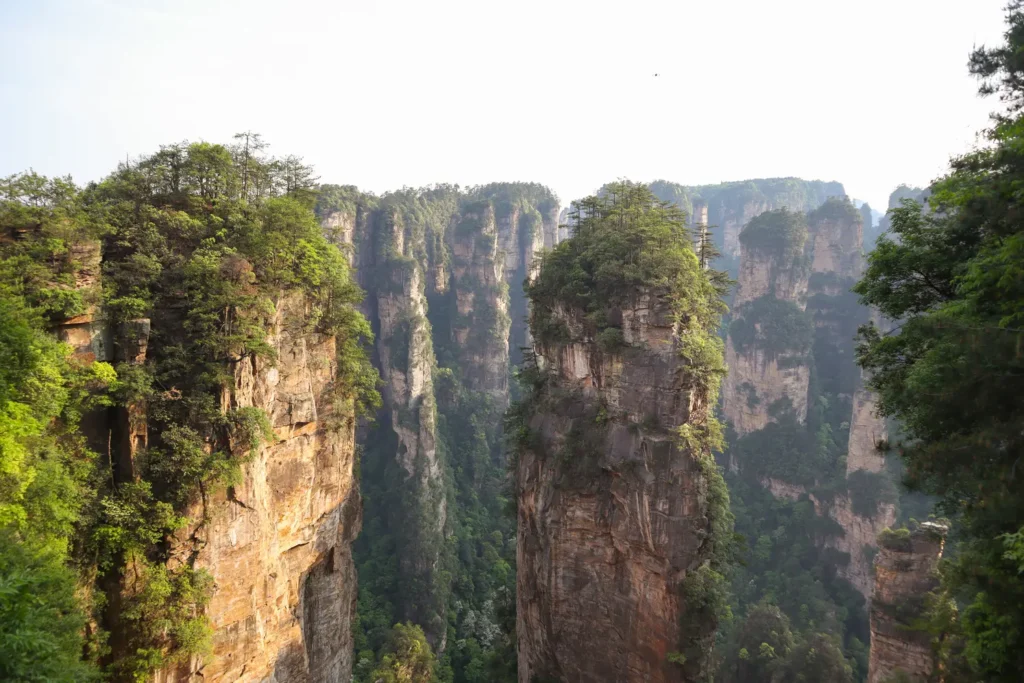
Planning a trip to Zhangjiajie can feel overwhelming at first. I hope this Zhangjiajie travel guide made things a little easier (and way more exciting). Once you’re there, trust me—it’s every bit as surreal and magical as the photos make it look.
Need help adapting this itinerary to your trip? Or just want to share your experience?
Drop a comment below—I love hearing from you and helping fellow travellers plan their adventure!
Disclaimer: this post may contain some affiliate links, which means I get a small commission if you buy something through my links. This doesn’t represent any additional cost to you and you’ll be supporting my work here on the blog😊

